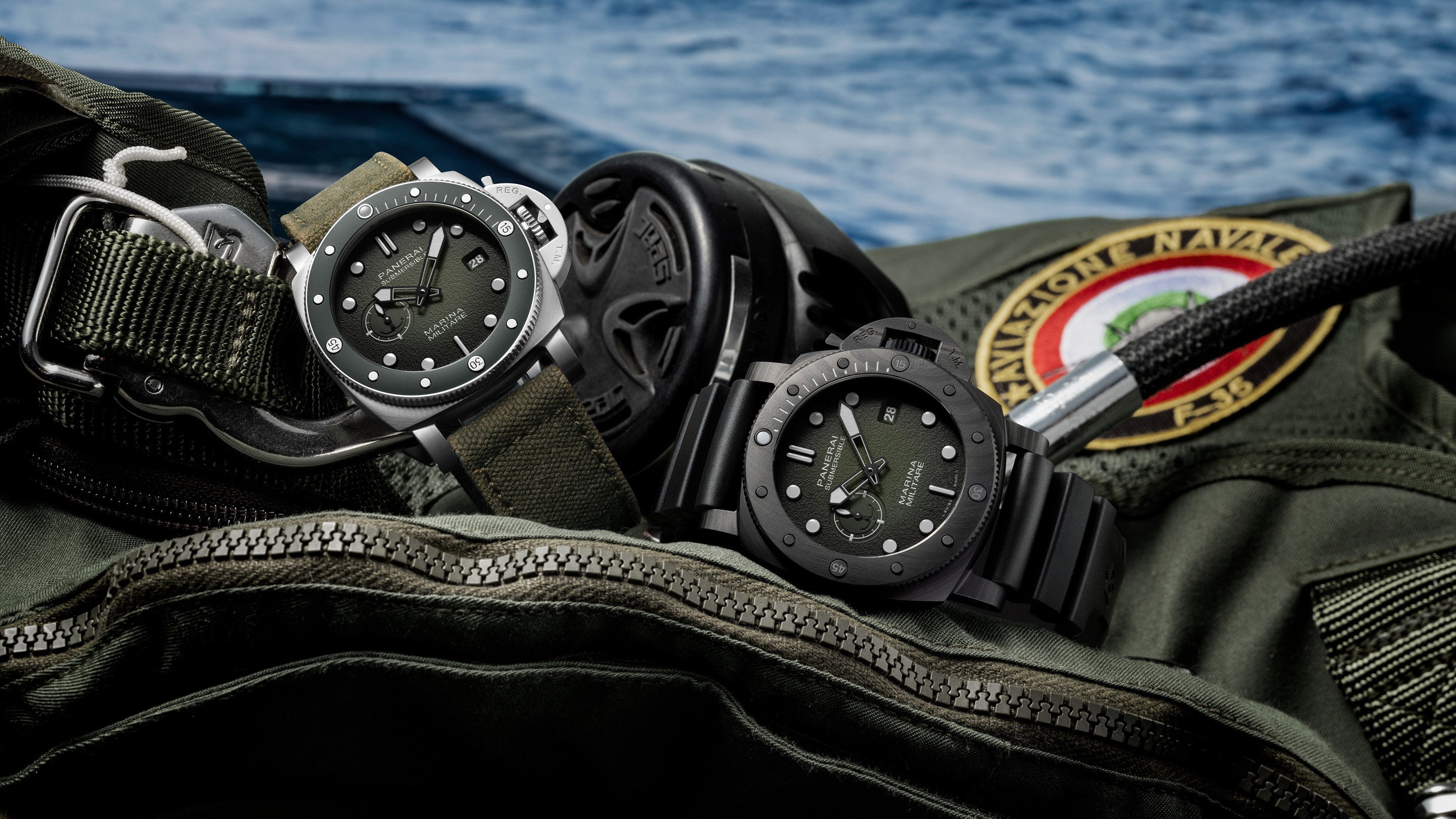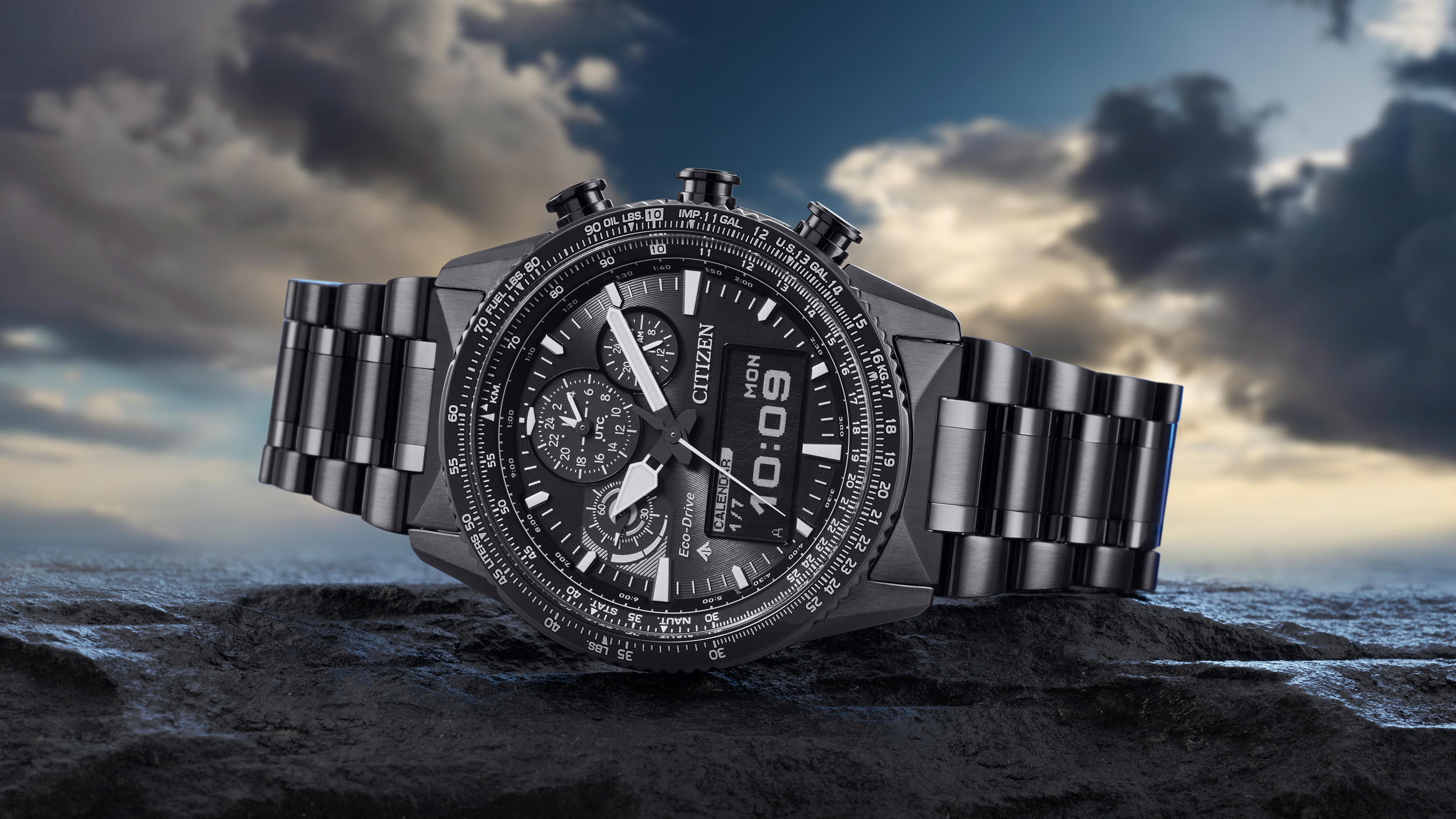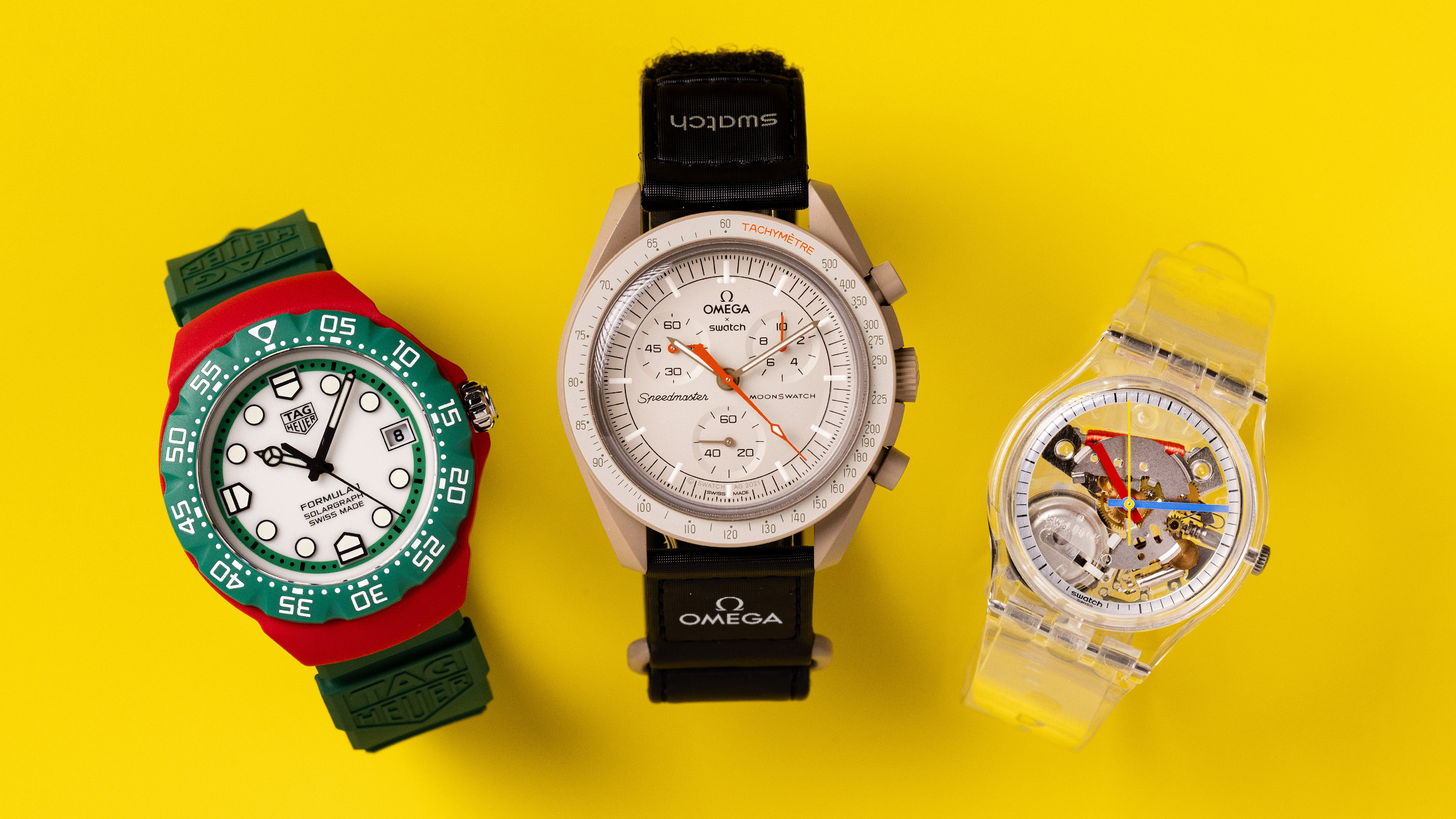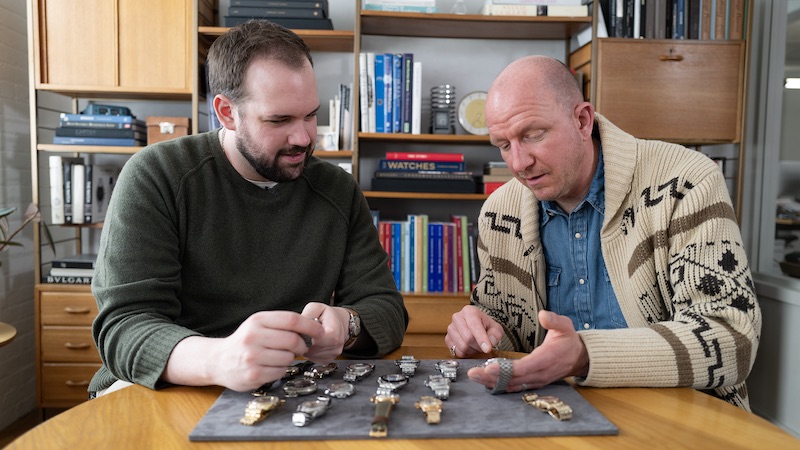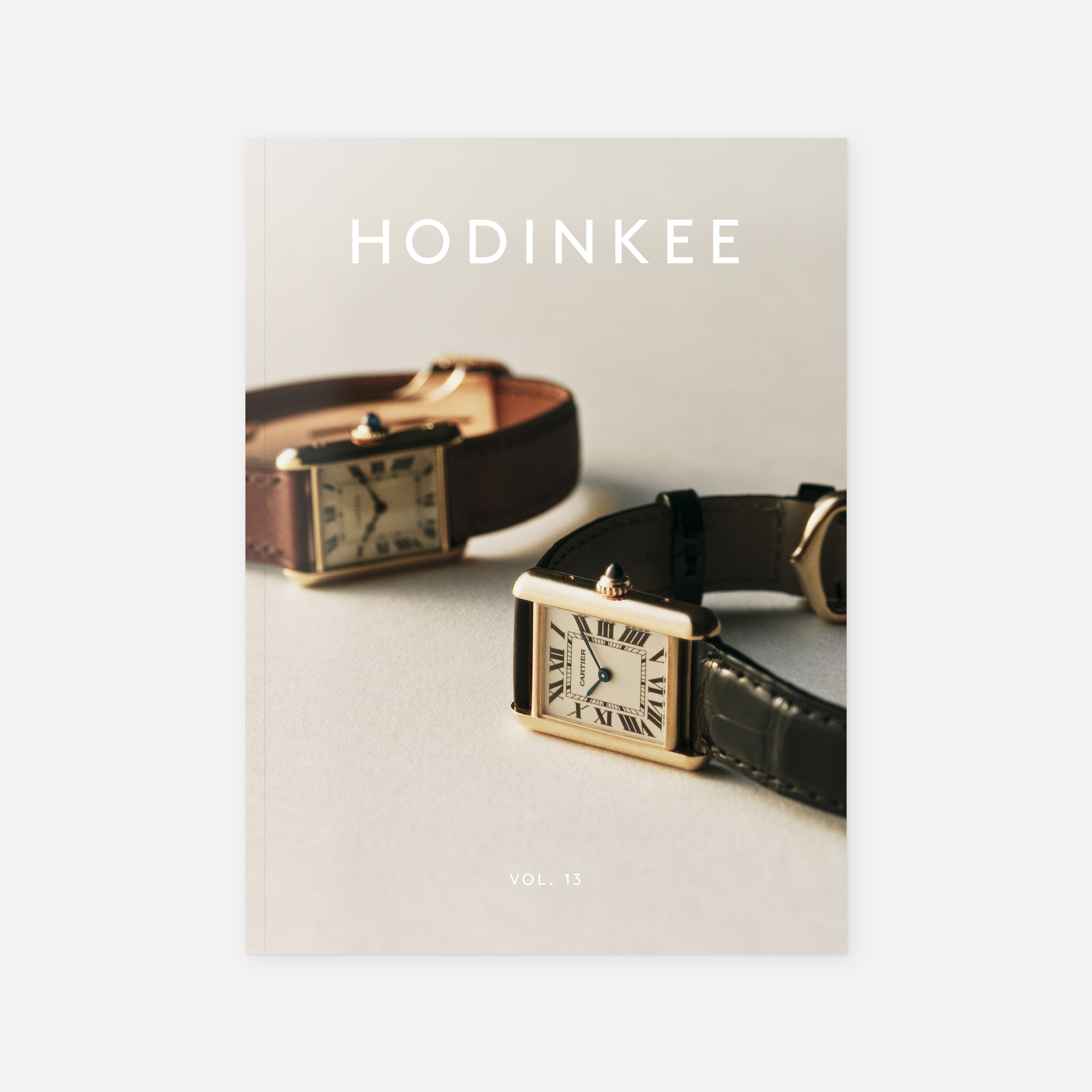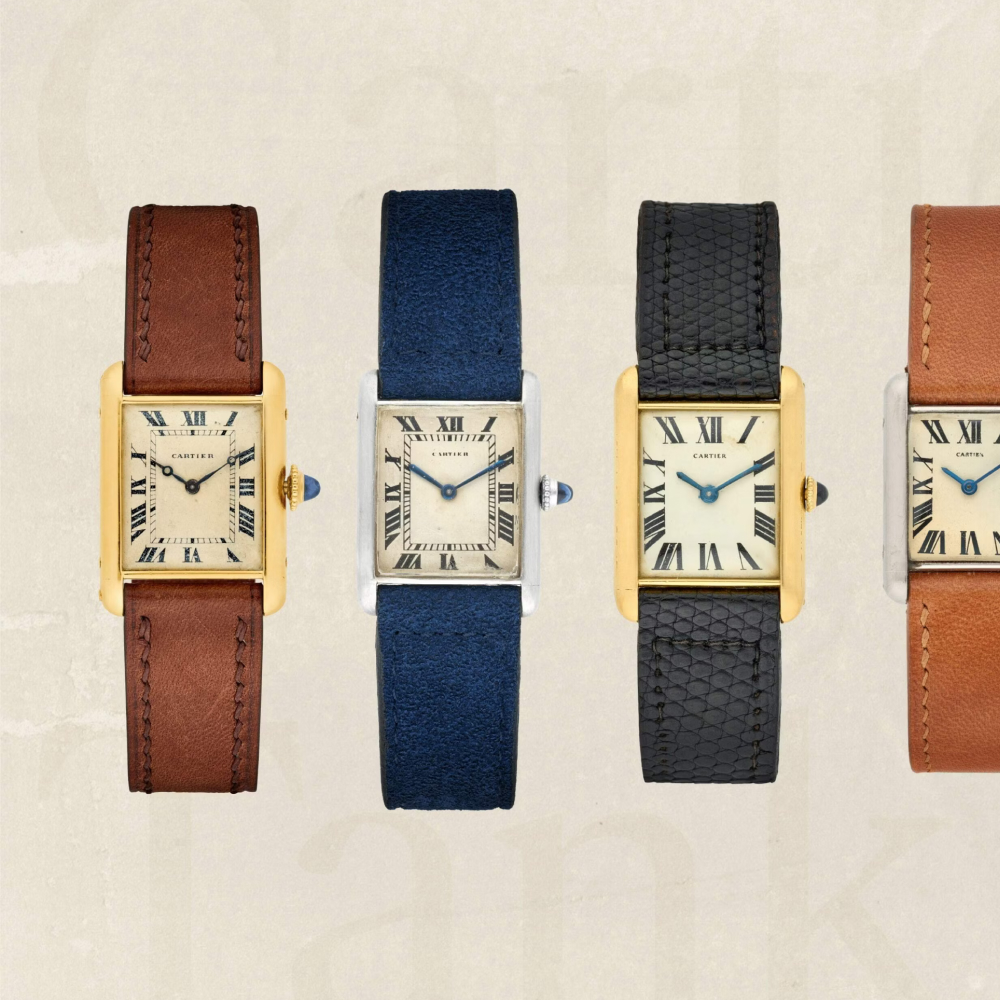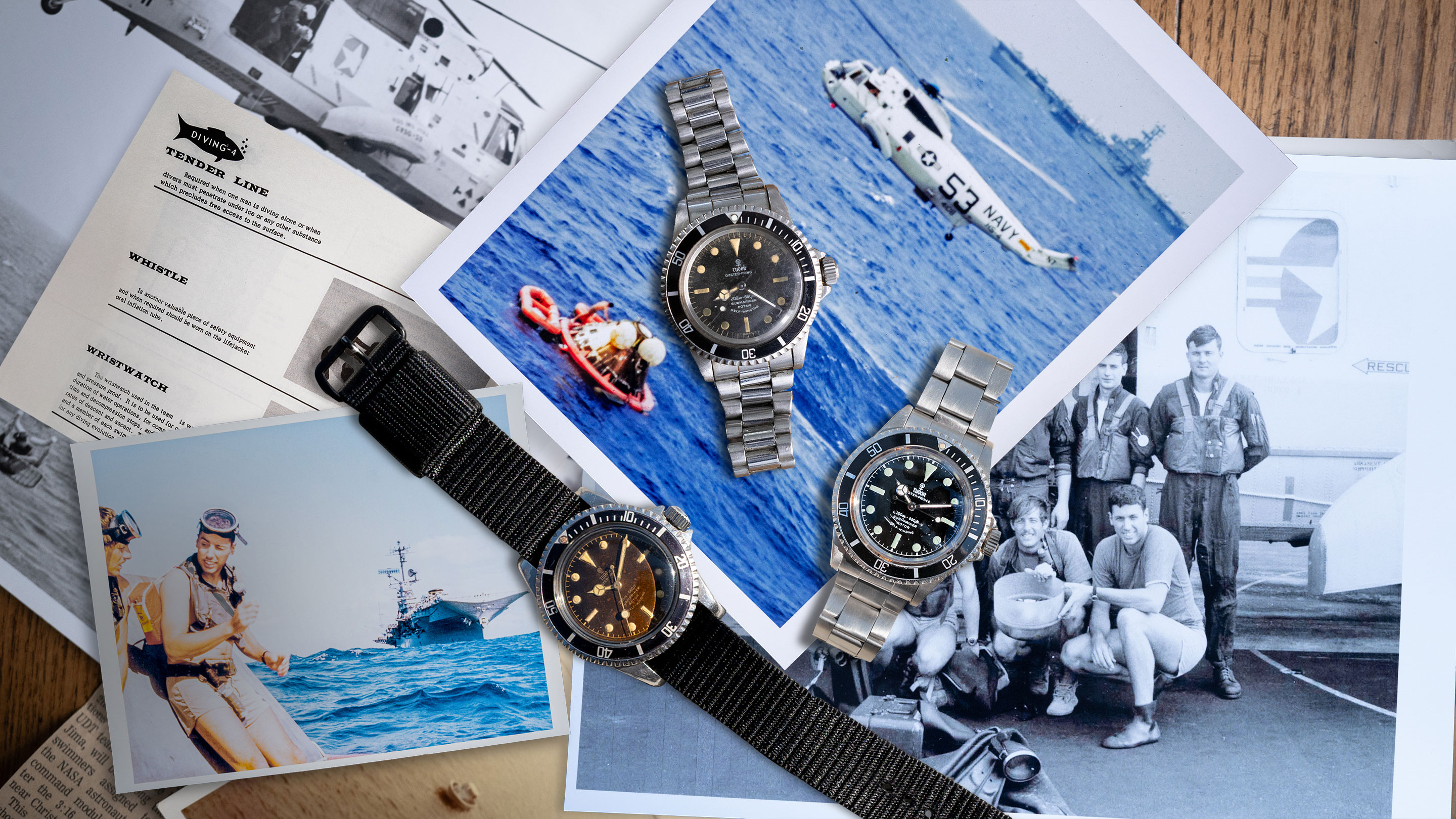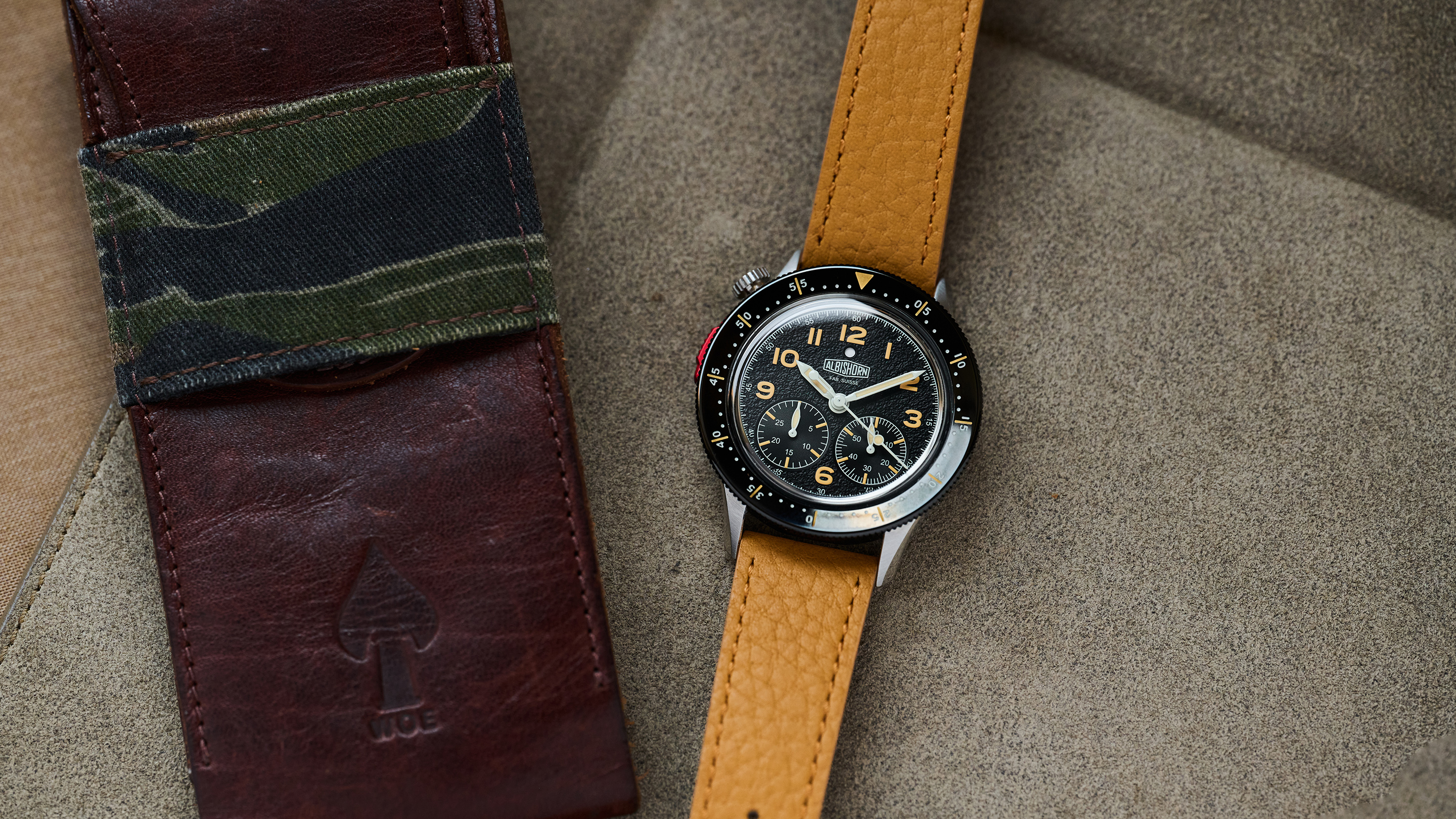and as our exhaustive look at the family points out</a>, it is also one of the brand’s most important watches. Vintage or modern, Patek’s perpetual calendar chronographs are among the most coveted and collectible of all wristwatches. The fact that no other watch has appeared on as many watch auction catalog covers is a testament to their collectibility and widespread appeal. The 5270’s introduction was remarkable as it was the first Patek perpetual calendar chronograph to use a 100% in-house designed and manufactured movement. For such an iconic watch, expectations were as high as it gets.</p>","dropcap":true},"type":"Block::BodyCopy"},{"data":{"size":"large","images":["70309f5d-53cc-4136-8b00-f14e7070a375"]},"type":"Block::InlineImageContainer"},{"data":{"copy":"<p>Like many others, I’d been waiting for its release for years – since Patek’s introduction of their first watch with <a href=https://www.hodinkee.com/"https://www.hodinkee.com/blog/five-super-cool-things-i-saw-inside-the-patek-philippe-factory-hint-i-actually-mean-seven/">a truly in-house chronograph movement in 2005, the absolutely superb reference 5959P</a>. Patek Philippe took on one of the most complex of all horological complications – the split-seconds chronograph – and created an all-new design packed with innovations. The result was the 27-525 PS, the world’s thinnest, split-second column wheel chronograph movement that quite literally wowed the watch world – <a href=https://www.hodinkee.com/"https://www.hodinkee.com/blog/a-quick-look-at-the-patek-philippe-5950a/">it is also used in the 5950A seen here</a>.</p>","dropcap":false},"type":"Block::BodyCopy"},{"data":{"size":"small","images":["525517d8-cb71-4ec9-b1be-197481d9149f"]},"type":"Block::InlineImageContainer"},{"data":{"copy":"<p>Though Patek was relatively late to introduce their first in-house chronograph (by comparison, Rolex introduced their own fully in-house chronograph in 2000), they made it crystal clear they would be THE dominant force to reckon with. Sure enough, the 27-525 was Patek’s first salvo in its in-house chronograph offensive. The following year, Patek introduced its first self-winding chronograph movement, <a href=https://www.hodinkee.com/"https://www.hodinkee.com/blog/introducing-the-patek-philippe-5960a-the-benchmark-annual-calendar-chronograph-now-availble-in-stainless-steel/">the in-house designed and manufactured caliber 28-520, featuring an all-new vertical-clutch design within the 5960P</a> Annual Calendar Chronograph, later rolled out to the Nautilus chronograph 5980.</p>","dropcap":false},"type":"Block::BodyCopy"},{"data":{"alignment":"inline_billboard"},"type":"Block::Advertisement"},{"data":{"size":"large","images":["47061fb6-cdaf-4e87-9c43-963a20050856"]},"type":"Block::InlineImageContainer"},{"data":{"copy":"<p>Three years later, in 2009, <a href=https://www.hodinkee.com/"https://www.hodinkee.com/blog/introducing-the-patek-philippe-5170g-todays-patek-chrono-now-available-in-white-gold-live-pics-pricing/">Patek introduced the caliber 29-535 PS</a> – a movement replacing the Nouvelle Lemania-based, manual-winding chronograph caliber 27-70 CH, in use by the brand since 1986. Until then, the 27-70 CH was used in the reference 5070 chronograph and was the base caliber for the reference 3970 and later reference 5970 perpetual calendar chronograph watches. Initially released within the ladies’ reference 7071 chronograph, the caliber 29-535 would soon be released in 2010 in the new mens’ reference 5170 chronograph that replaced the 5070.</p>","dropcap":false},"type":"Block::BodyCopy"},{"data":{"size":"small","images":["1497f129-93f5-4852-858f-0781e02d9cbc"]},"type":"Block::InlineImageContainer"},{"data":{"copy":"<p>With enthusiasts, collectors, and industry professionals eagerly waiting, Patek finally released the 5270G, an all-new perpetual calendar chronograph based on the 29-535 PS, in 2011. Perhaps by coincidence, it was also the 70th anniversary of the release of Patek’s first perpetual calendar chronograph – the reference 1518 launched in 1941.</p>","dropcap":false},"type":"Block::BodyCopy"},{"data":{"alignment":"inline_billboard"},"type":"Block::Advertisement"},{"data":{"size":"h3","headline":"The Dial(s)"},"type":"Block::Headline"},{"data":{"copy":"<p>The 5270’s dial layout reflects the fact that it is a direct descendant of the 1518, retaining most indicators of its predecessors – the 1518, 2499, 3970, and 5970. Like all of them, the 5270 indicates the day and month in apertures at 12 o’clock, the date with moon phase at 6 o‘clock, a 30-minute counter for the chronograph at 3 o’clock, and seconds indication at 9 o’clock.</p>","dropcap":false},"type":"Block::BodyCopy"},{"data":{"size":"small","images":["925c262e-9e4d-45a3-8b65-8d800dddf92b"]},"type":"Block::InlineImageContainer"},{"data":{"copy":"<p>Some important dial differences differentiate the 5270 from its predecessors. Most notably, the seconds indication and minute counter now reside below the center, horizontal axis of the dial. It’s believed this was done to easily identify fakes now and in the future. But at the same time, it made Patek’s life more difficult. The repositioning of these hands in the 29-535 PS rendered the perpetual calendar module developed for the 3970 and 5970 obsolete. An all new module was required, taking Patek two years of development to complete.</p>","dropcap":false},"type":"Block::BodyCopy"},{"data":{"size":"small","images":["c1fd8d8f-0cab-4919-a89b-060904602aa5"]},"type":"Block::InlineImageContainer"},{"data":{"copy":"<p>For improved readability, the day/night and leap-year indicators were removed from the 9 and 3 o’clock subdials, as found on the 3970 and 5970. Instead, they were placed within small apertures to the right and left of the date/moon phase subdial at 6 o’clock, taking inspiration from the leap-year aperture first used by Patek in the reference 3450 perpetual calendar launched in 1981. The day/night indicator transitions continually, from full white to full blue over the course of 24 hours, where the white color indicates daytime, and the blue color indicates nighttime.</p>","dropcap":false},"type":"Block::BodyCopy"},{"data":{"size":"small","images":["df595a34-ed55-42fa-88dd-43c21af80481"]},"type":"Block::InlineImageContainer"},{"data":{"copy":"<p>Since the 5270’s release, three different dials were introduced. The first variant, found in watches with reference 5270G 001, eliminated the tachometer scale included on 5970 dials. Similar instead to the dials on the now-discontinued reference 5004 perpetual calendar with split seconds chronograph, the outer circumference featured a seconds track for the chronograph with 1/5th second sub-divisions, minus the markers at each minute position. A second, closed, railroad-type minute track lies just inside the outer seconds track. Finally, with more room on the upper half of the dial due to the lower-positioned subdials, the font size of the \"Patek Philippe\" brand name at 12 o’clock was significantly increased compared with the size used on the 5970. The hands and applied hour markers are black-oxydized gold.</p>","dropcap":false},"type":"Block::BodyCopy"},{"data":{"size":"small","images":["2058b016-3d14-4cf5-91c3-0fc75202336d"]},"type":"Block::InlineImageContainer"},{"data":{"copy":"<p>In late 2013, <a href=https://www.hodinkee.com/"https://www.hodinkee.com/blog/patek-philippe-quietly-updates-the-look-of-its-benchmark-5270g-perpetual-calendar-chronograph-with-two-new-dials/">Patek discontinued the 5270G 001 and released a second dial type for the 5270G</a>. Two different colors were introduced – one with a silver opaline dial, reference 5270G-013, and one with a blue sunburst dial, reference 5270G-014 – the subject of this week on the wrist review. The hands and applied markers were changed to white gold. Both re-introduced a tachometer scale along the outer circumference. A combined, open, railroad-track ring scaled for both the chronograph seconds and timekeeping minutes lies just inside the tachometer. The seconds and 30-minute counter subdials were modified to include closed, railroad-track scales, while their centers are sunk, or stepped, with a very fine, concentric circle guilloché pattern found inside them.</p>","dropcap":false},"type":"Block::BodyCopy"},{"data":{"size":"small","images":["3e8d06a4-183d-487c-9468-69d32bb6f178"]},"type":"Block::InlineImageContainer"},{"data":{"copy":"<p>Perhaps the most polarizing characteristic of these second-generation 5270 dials is the noticeable depression of the chronograph seconds/minute track at 6 o’clock. Known as “the chin,” it’s as though the placement of the subdial hands beneath the dial’s centerline forced the lowering of the date/moon phase subdial into the seconds/minute track.</p>","dropcap":false},"type":"Block::BodyCopy"},{"data":{"size":"small","images":["e631eb32-2dcc-45b4-88b1-7bf492657ec7"]},"type":"Block::InlineImageContainer"},{"data":{"copy":"<p>It’s a design “feature” I strongly dislike, and here’s why. Performance and accuracy are the raison d’être for a chronograph, particularly one made by Patek Philippe. This depressed region places the seconds track out of the chronograph hand’s reach. So if the chronograph hand is stopped between 27 seconds and 33 seconds, the correct reading of the time becomes very difficult with the naked eye. There have been countless snarky comments made by collectors about \"the chin,\" but aesthetics aside, I believe it is a fundamental flaw in the design of this chronograph's dial – if we are to view the 5270 as a functional object, which of course, most do not.</p>","dropcap":false},"type":"Block::BodyCopy"},{"data":{"size":"small","images":["3f22c9ae-4bbb-42e5-8cc6-8ffe904c216f"]},"type":"Block::InlineImageContainer"},{"data":{"copy":"<p>Speaking of precision, as mentioned, the 5270’s chronograph seconds track is calibrated for 1/5th second intervals. However, the 29-535 PS inside the 5270 has an oscillation rate of 28,800 beats per hour (bph), corresponding to 1/8th second accuracy. The 1/5th scale perfectly matches the 18,000 bph rate of the CH 27-70 used in the 3970 and 5970, so with the increased beat rate of the 29-535, I would have like to see 1/8th second intervals for the chronograph seconds track. This and “the chin” are two discordant design elements I was disappointed by. For most others, these are minor issues in an otherwise highly legible, pleasingly well-balanced and symmetric dial.</p>","dropcap":false},"type":"Block::BodyCopy"},{"data":{"size":"small","images":["11b16d89-6b2f-4f15-9a88-e99348a0365d"]},"type":"Block::InlineImageContainer"},{"data":{"copy":"<p>Fortunately for those in my camp, the third generation dial <a href=https://www.hodinkee.com/"https://www.hodinkee.com/blog/introducing-the-patek-philippe-5271p/">found on this year’s new reference 5271P</a> – the first platinum-cased, black-dialed version of the 5270 – eliminated the chin. The tachometer scale and chronograph seconds track were separated, and the “Patek Philippe” font size at 12 o’clock was significantly reduced. In my humble opinion, it’s the best dial yet, even though the chronograph seconds track is still calibrated with 1/5th second intervals. My hope is that the 5271P’s dial design becomes the basis for all variations of the 5270.</p>\n<p><strong>The Movement</strong></p>\n<p>The 29-535 PS Q is where the 5270 really shines.</p>","dropcap":false},"type":"Block::BodyCopy"},{"data":{"size":"small","images":["8688672f-fe8b-4061-a855-8f03e1728c29"]},"type":"Block::InlineImageContainer"},{"data":{"copy":"<p>The 2011 launch of the 5270 marked the end of Patek’s reliance on other companies for any of their movements. The movement is based on the in-house, chronograph caliber 29-535 PS, originally launched in 2009 following five years of development. Within it, Patek utilized innovations leveraged from the ultra-thin, split-second chronograph caliber 27-525 PS, while applying lessons learned and improving upon shortcomings they found within the Nouvelle Lemania-based caliber 27-70 CH.</p>\n<p>Consider a chronograph mechanism as a separate module, which, through a “clutch,” is coupled to the movement to power the chronograph’s indicators once activated. For traditional and aesthetic reasons, Patek opted for a classic, column-wheel-based architecture employing a lateral-clutch engagement mechanism. The alternative, a vertical clutch, was used by Patek in their self-winding CH 28-520 caliber launched in 2006 and used in references 5960 and 5980. Vertical-clutch coupling has some advantages, such as greater efficiency and less jitters on the hands when the chronograph is started/stopped/reset. However, for a large-diameter, manual-winding movement, the aesthetics of the bridges and their layout would have been comparatively unappealing if a vertical-clutch-based design was used.</p>","dropcap":false},"type":"Block::BodyCopy"},{"data":{"size":"large","images":["5051c4eb-2bdd-4f4e-a08c-6575d4571b13"]},"type":"Block::InlineImageContainer"},{"data":{"copy":"<p>Patek addressed the weaknesses of the lateral-clutch mechanism, focusing on functionality, reliability, and performance. Their knowledge basis for doing so was as good as it gets. Patek had extensive experience reworking one of the greatest manual-winding, lateral-clutch chronograph calibers of all time – the Nouvelle Lemania 2310. Building off the same caliber found in early Omega Speedmasters that went to the moon (the Omega caliber 321), Patek performed extensive modifications to extend the 2310’s power reserve and improve its escapement, while finishing it to its highest standard. Reworked into the Patek caliber 27-70 CH, it performed admirably in the reference 5070 chronograph and perpetual calendar chronograph references 3970 and 5970.</p>","dropcap":false},"type":"Block::BodyCopy"},{"data":{"size":"large","images":["9cb93718-2d58-4663-a624-ae0da1efcc1b"]},"type":"Block::InlineImageContainer"},{"data":{"copy":"<p>With this unmatched experience, the new caliber 29-535 PS was designed from the ground up, incorporating six patented innovations that virtually eliminate the weaknesses found in prior lateral-clutch chronographs. The highlights of these innovations include:</p>\n<p>1. <strong>Optimized tooth profile</strong> – The gears in the chronograph mechanism use teeth with a patented shape, so that when they engage with one another, there is minimal play between them. The design was first used in the 27-525 split-seconds chronograph caliber, and eliminates hand jumps (jitters), increases energy efficiency, and reduces friction for longer service intervals.</p>\n<p>2. <strong>Functional column-wheel cap</strong> – A hallmark of a very high grade chronograph is a well finished “cap” covering the column wheel. It was a feature required for the Geneva Seal, and was consistently used by Patek for over a century. Previously just a cosmetic feature, with the 29-535, Patek made the column-wheel cap functional. It’s now used to enable precise adjustment and penetration for the clutch that engages the chronograph wheel, simplifying assembly and servicing, while improving the chronograph’s performance.</p>\n<p>3. <strong>Pierced-out minute cam</strong> – A new slot in this cam serves to significantly reduce the quivering of the chronograph hand when it returns to zero upon pressing the reset button at four o’clock.</p>\n<p>4. <strong>Synchronization between the clutch lever and blocking leve</strong>r – Without getting too technical, Patek employed a simplified design between these two levers in order to suppress unwanted jumping of the chronograph seconds. When started or stopped, the chronograph hand begins and stops precisely where it should.</p>\n<p>In addition, the 29-535 PS incorporates a wonderful, instantaneous minute counter. When the chronograph seconds hand crosses the 60-second mark, the minute hand at 3 o’clock jumps instantaneously to the next minute. It’s absolutely delightful to watch, and gives the wearer the sense that they are holding an instrument built with precision.</p>","dropcap":false},"type":"Block::BodyCopy"},{"data":{"size":"small","images":["45e79910-b8f4-4fde-9698-30f41a1e1618"]},"type":"Block::InlineImageContainer"},{"data":{"copy":"<p>An advantage of a lateral-clutch architecture is that it allows an owner to see exactly how the chronograph mechanism works. The bridges were shaped with classical curves, and are laid out in an open, logical manner. Finishing is superb throughout, with hand-finished beveling and chamfers on all visible edges, screws, and screw slots.</p>","dropcap":false},"type":"Block::BodyCopy"},{"data":{"size":"small","images":["ebd77e43-e026-4033-866a-836eb1c76ceb"]},"type":"Block::InlineImageContainer"},{"data":{"copy":"<p>Fitted atop the chronograph mechanism is an all-new perpetual calendar module designed to fit the new 29-535 architecture. The module, with 182 parts, is exceptionally thin, measuring just 1.65 mm in diameter, with a diameter of 32 mm, making it slightly wider than the 29.6 mm base chronograph caliber. The total thickness of the movement is just 7.0 mm, 2/10th’s of a millimeter thinner than the 27-70 CH.</p>\n<p>It incorporates a more precise moon-phase indicator than its predecessor – accurate to one day every 122 years. While not the most accurate moon phase on the market (that distinction belongs to Lange at the moment), it’s pretty darn good.</p>","dropcap":false},"type":"Block::BodyCopy"},{"data":{"size":"fullbleed","images":["8ee22c76-6c17-4c07-b40f-cb07af891f13"]},"type":"Block::InlineImageContainer"},{"data":{"copy":"<p>A very high quality, free-sprung escapement with a Phillips overcoil and a Gyromax balance wheel oscillating at 28,800 bph regulates the 29-535. A significant increase over the 18,000 bph rate of the 27-70 CH, the higher rate enables high accuracy even when using a smaller diameter balance wheel. Patek’s “Patek Philippe Seal” criteria requires rate accuracy between -3 to +2 seconds per 24-hour period for movements larger than 20 mm in diameter. The rate accuracy performance of this example was exceptional. After my test period, with winding performed every 24 hours, the observed accuracy was +2 seconds over the four days (+0.5 sec/day average) during which I measured its performance.</p>","dropcap":false},"type":"Block::BodyCopy"},{"data":{"size":"small","images":["2b4f6379-37f6-4deb-a32a-cb4b43b398da"]},"type":"Block::InlineImageContainer"},{"data":{"copy":"<p>Compared with the balance wheel of the 27-70 CH, the 29-535’s is significantly smaller, and uses just four adjustable masses versus eight found on the 27-70 CH. Personally, I prefer the slower beat rate with larger balance wheel, as the 28,800 bph rate sounds hurried and rather non-traditional. Also, the use of just four masses on the balance seems like a cost-cutting measure more appropriate for a watch retailing for less than those using this movement.</p>","dropcap":false},"type":"Block::BodyCopy"},{"data":{"size":"small","images":["bf2c1819-ac71-4e2d-a23a-eac95ee1d04f"]},"type":"Block::InlineImageContainer"},{"data":{"copy":"<p>These minor quibbles aside, I believe Patek Philippe hit a home run in creating a beautiful chronograph caliber that will stand the test of time. Through its sapphire caseback, this in-house Patek Philippe caliber looks simply stunning, and to some purists, more appealing in its traditional architecture than even A. Lange & Söhne's deep, three-dimensional chronograph calibers.</p>","dropcap":false},"type":"Block::BodyCopy"},{"data":{"alignment":"inline_billboard"},"type":"Block::Advertisement"},{"data":{"size":"h2","headline":"(A Week) On The Wrist"},"type":"Block::Headline"},{"data":{"size":"fullbleed","images":["a14ee5d9-dd6f-4855-96dc-fdc138603feb"]},"type":"Block::InlineImageContainer"},{"data":{"copy":"<p>With a case measuring 41 mm in diameter and 12.4 mm thick, it’s Patek’s largest perpetual calendar chronograph to date. Retaining the concave bezel and similarly stepped and flared lugs used in the 5970, the water-resistant case is masculine and balanced. It’s 1 mm wider than the 5970 and, impressively, 0.6 mm thinner. These updated dimensions work superbly – the proportions are just about perfect for my sensibilities. Thanks to its well-proportioned case and curved lugs, the 5270 fit my rather small, 6.75-in. wrist well, and I imagine it will comfortably fit nearly all wrist sizes. The placement of the square-shaped pushers and crown is beautifully centered. Overall, I give an A+ to Patek for the 5270’s case design.</p>","dropcap":false},"type":"Block::BodyCopy"},{"data":{"size":"large","images":["41f4a74a-d433-4849-8b03-f3768c44b288"]},"type":"Block::InlineImageContainer"},{"data":{"copy":"<p>The expansive dial is highly legible, with a drop dead gorgeous shade of blue treated with an eye-catching sun-ray pattern. All indicators are logically laid out and simple to read at a glance.</p>","dropcap":false},"type":"Block::BodyCopy"},{"data":{"size":"small","images":["b6d68cf8-95a5-4e11-82a0-cfa43eff0edb"]},"type":"Block::InlineImageContainer"},{"data":{"copy":"<p>The tactile feel of starting, stopping, and resetting the chronograph pushers was outstanding to me, and certainly among the best I’ve encountered. The resistance of the pushers on this example may be a bit too tight for some, however. As I operated the chronograph, no jumps or jitters were observed on any of the hands. The chronograph hand stopped exactly where it should, and when resetting, it returned to zero perfectly each time without a quiver visible to my eyes. Watching the minute counter advance instantaneously to the next minute was a delight – so precise, and so quick. Its outstanding operational performance made it clear to me: Patek succeeded in creating a state-of-the-art, manual-winding, lateral-clutch chronograph caliber in the 29-535.</p>","dropcap":false},"type":"Block::BodyCopy"},{"data":{"size":"small","images":["16a9c007-4710-4d8d-90d9-295533c6385b"]},"type":"Block::InlineImageContainer"},{"data":{"copy":"<p>Regarding the perpetual calendar, I observed the following transitions for the indications:</p>\n<p>- Day advance: Begins at 11:15 p.m., complete by 12:03 a.m.</p>\n<p>- Day/night advances: Continuous</p>\n<p>- Date advance: Begins at 11:58 p.m., complete by 12:23 a.m.</p>\n<p>- Moon phase advance: Immediately at 12:45 a.m.</p>\n<p>- Month advances: Immediately at 12:25 a.m.</p>","dropcap":false},"type":"Block::BodyCopy"},{"data":{"size":"large","images":["9cb87246-02df-4004-85a3-356479937c62"]},"type":"Block::InlineImageContainer"},{"data":{"copy":"<p>With an all-new perpetual calendar module designed specifically for the 29-535 base, it would have been great to see instantaneous transitions for the day and date indicators occurring at exactly 12:00 a.m. Instantaneous calendar indications would have added considerable complexity, so Patek likely opted for gradual calendar transitions due to the potential negative impact on timekeeping accuracy and reliability. A noble design choice, in my view.</p>","dropcap":false},"type":"Block::BodyCopy"},{"data":{"alignment":"inline_billboard"},"type":"Block::Advertisement"},{"data":{"size":"h3","headline":"Collectibility"},"type":"Block::Headline"},{"data":{"size":"fullbleed","images":["d3e8a283-28e7-41a1-a5e1-9cf3eaf4f086"]},"type":"Block::InlineImageContainer"},{"data":{"copy":"<p>One can not discuss a perpetual calendar chronograph from Patek Philippe without mentioning the potential long-term collectibility of a particular reference. How does the 5270 fit in with its predecessors? The verdict is still out on that, as the watch is still very much alive and Patek references rarely build steam until after they have been discontinued. I will say that the 1518, 2499, 3970, and 5970 are all fanstastic pieces, each with their fans, and the simple fact that they are discontinued helps their desirability for long-term collectors.</p>\n<p>Additionally, production for all previous references was limited by supply from outside movement companies – Valjoux first, then Lemania. We know roughly how many of each reference was produced and we also know that no more will ever be made. We cannot say that about this new reference, as Patek holds all the keys to production. However, I believe the 5270 to be a watch of great significance, containing the first in-house mechanism for this great combination of complications. Add to that the largest diameter in the family, and more than one dial variation, and down the road, the 5270 could very well be a very collectible piece. The 5270-001 (introduced in 2011 and discontinued in 2013) is already experiencing increased demand from collectors, especially those with an aversion to the \"chin.\"</p>","dropcap":false},"type":"Block::BodyCopy"},{"data":{"size":"large","images":["e3e1a514-f57b-4505-aa37-8470c75b064d"]},"type":"Block::InlineImageContainer"},{"data":{"copy":"<p>Additionally, the current two dial options are pleasing to many who disliked the oversized \"Patek Philippe\" logo on the original. The blue dial, as seen in this review, seems to be favored among collectors, and to quote one collector friend who now owns this very watch, \"with the blue dial, they fixed the watch.\" Further, Patek produced a limited edition 5270G exclusively for German retailers last year, and <a href=https://www.hodinkee.com/"http://www.christies.com/lotfinder/watches/patek-philippe-a-fine-18k-white-gold-5808537-details.aspx/">those examples are already selling well above retail at auction</a>. So, while some might say the 5270 lacks some of the charm of the pre-manufacture movement pieces, the high-end movement, large size, dial variations (which will undoubtedly lead to collectors defining different \"series\" of this watch), and the overall attractiveness of 5270 could make this a very desirable piece for generations.</p>","dropcap":false},"type":"Block::BodyCopy"},{"data":{"alignment":"inline_left"},"type":"Block::Advertisement"},{"data":{"size":"h2","headline":"Conclusion"},"type":"Block::Headline"},{"data":{"copy":"<p>There is so much to love about the 5270. It’s fitted with an absolutely superb in-house movement housed by a perfectly balanced and proportioned case. I’ll admit, I was a skeptic on the new 29-535 PS, believing it would not function as well as the legacy caliber 27-70. I was truly impressed by its operational performance and accuracy.</p>\n<p>The dial is expansive, logically laid out, and easy to read. The polarizing “chin” found on the dials of the 5270G-013 and 5270G-014 is the only issue I consider a significant design weakness. In all fairness, it’s a criticism based on personal taste that many will disagree with. And it’s one that’s easily rectified if or when the dial of the new 5271P is fitted across all variants.</p>\n<p>I believe the 5270 to be among the finest mechanical watches produced in Switzerland today, combining historical aesthetics and architecture with modern technical upgrades. The 5270 is very much a modern watch that pays respect to those that came before it, and a worthy carrier of this great family's torch.</p>\n<p>The Patek Philippe 5270G retails for $176,300 and <a href=https://www.hodinkee.com/"https://www.patek.com/contents/default/en/5270G_014.html/">more details may be seen here</a>.</p>","dropcap":false},"type":"Block::BodyCopy"},{"data":{"size":"h2","headline":"Full Specs"},"type":"Block::Headline"},{"data":{"size":"small","images":["51a237fb-e5ff-4346-8e4d-8ed554bbe646"]},"type":"Block::InlineImageContainer"},{"data":{"images":["f03b809f-63a7-406a-9744-4a43c10cfda3","0463144d-b8e2-47cc-9406-382819182e00","838b9fee-b81d-41e6-9e8b-a196b71e581c","f9154b84-f8be-4d72-b574-92de5de53a2d","6875c89e-798b-40f1-8589-16310922f412","17da9ca3-b4ea-4358-b1e6-44c066721ffe","d7ce28a5-4814-4245-b692-c7fb7c925c1f","d5c97f1a-951b-4b5b-a12c-f5a6e8f065ca","7c5c9d7a-3882-4a65-9de2-020bf4c66461","51ba4451-ba71-441c-997e-d7839791edb5","61f0d7a9-e38e-4612-b5d5-d44623ad675d","588ff40c-c12f-4309-948f-9644f09cb61f","324fc660-c735-4523-a272-66d28892e23d","481d1ccf-189d-40cd-9852-6320d2d9036c","be90ed45-cfb6-4cad-b629-2bb0e0aa4e72","c16ffc02-6452-45c1-80bc-3840dce9f65f","1149911e-2832-488f-9810-ca85d72b276c","edf59a67-7df1-4543-a4c2-1042e9c1b3c3","9129215c-2fff-44cb-bca5-386da7587fe9","e75f8088-e165-4677-af8c-677d1d6ce971","6171c118-bd83-48a1-94ec-558ccf3da636","bdf15e38-4b79-441f-afbd-a21c9212eac9","70f367f7-beb5-4ebe-8f97-d9706db4b211","8158a216-b2c6-480a-925e-38b4309d0809","09e34755-2ba7-4c56-930c-0ec88d095392","c75d10f2-27ce-41e9-bf76-c9b546f9877a","19d68548-2ec7-47d4-84f9-1424e6a696ab","8dbcad1d-624f-4d04-aa17-d8f1404d15f5","b45cf40a-48fa-413f-83a5-ce79ac0f0c66","bfb935cf-58c5-4c4f-8f9f-46b997e37fe5","682a6e31-8f88-4397-81e1-b4950284fdb9","0127ed4a-3bde-411a-ab00-fcf46b230b2d","5fc1459c-8203-4655-ae8f-8f8b900b7b34","8553fe23-0e4f-40ed-807a-f23485a36626","259abb97-d4f6-462f-a243-ce4c1449f98f","2fec9420-8daf-4339-a3aa-fc28c059aeff","964d739f-6b49-45e4-bb58-3444ee5f67b3","8d0fa5cd-aef3-4d74-a761-b4fae88f9a55","e3e0abb2-628e-4479-baa6-89611f9a1275","311445a0-3e3e-4da9-aa92-afb4d853704a","7163f162-95d5-4464-bc2e-f80b1e3ffc62","70b2a820-286c-4289-93ea-4a1ffa77f17e","01b98bda-696d-47a0-9e3f-2c85cd9e9dff","24f140ff-aa26-4dce-9656-6dc2370ca2b5","07bb9a57-30f3-4f89-abfd-6a6cd84a25a5","f851065f-99d8-4292-b63f-cb631fca2886","6985256b-959a-44c2-b06f-d3ab59c72231","20053eff-081d-48c8-a082-b71f7704e090","6b51f0ba-0fff-41ad-abc2-23654275f44a","2f0aad7d-b8b1-4aac-af64-54ac0aa8f911"]},"type":"Block::Gallery"}],"migrated_content":true,"meta_title":null,"meta_description":null,"meta_social_media_headline":null,"meta_social_media_description":null,"meta_social_media_image":null,"artist_name":null,"artist_type":null,"internal_notes":null,"column":{"id":2,"slug":"a_week_on_the_wrist","name":"A Week On The Wrist","description":"A popular video series in which HODINKEE editors test-drive a watch in a variety of situations over the course of a week – and report back on their findings.","sort_order":0,"created_at":"2016-07-13T12:24:43.938-04:00","updated_at":"2022-05-04T13:56:14.372-04:00","status":"visible"},"hero_image":{"id":"8a60cdb4-c355-46e1-a151-51dbe43b62d0","container_id":1628,"container_type":"Article","url":"https://cdn.hodinkee.com/uploads/article/hero_image/1628/_img.jpg","width":1500,"height":1000,"format":"jpg","render_args":null,"caption":"<p></p>","alt_text":null,"created_at":"2017-02-20T20:30:05.288-05:00","updated_at":"2017-04-23T17:33:34.618-04:00","sort_order":0,"product_ids":null,"imgix_url":"https://hodinkee.imgix.net/uploads/article/hero_image/1628/_img.jpg?ixlib=rails-1.1.0"},"share_url":"https://www.hodinkee.com/articles/patek-philippe-5270g-review","full_title":"A Week On The Wrist: The Patek Philippe 5270G Perpetual Calendar Chronograph","tags":["patek-philippe","a-week-on-the-wrist"]},{"id":179,"slug":"in-depth-jaeger-lecoultre-master-compressor-extreme-lab-2-live-pics-pricing","column_slug":"in_depth","title":"My Time With The Jaeger-LeCoultre Master Compressor Extreme LAB 2 (Live Pics & Pricing)","status":"published","working_copy_of_id":null,"published_at":"2013-08-14T09:12:22.000-04:00","created_at":"2015-02-26T10:42:46.000-05:00","updated_at":"2021-06-23T10:33:03.435-04:00","scheduled_for":null,"review_status":null,"package_id":null,"lede":"<p>The Master Compressor Extreme LAB 2 is one of the most exciting – and radically different – watches in Jaeger-LeCoultre’s collection. It is mechanically complicated, conceptually innovative, and stylistically interesting. Here we take an in-depth look to unpack everything the Extreme LAB 2 has to offer, along with some thoughts on the watch as a whole, written by Paul Boutros.</p>","hero_media_type":"image","hero_video_id":"","hero_video_type":"vimeo","hero_homepage_image":null,"gallery_view":false,"legacy_url":"/blog/in-depth-jaeger-lecoultre-master-compressor-extreme-lab-2-live-pics-pricing","multiple_authors":false,"pinned_related_article_id":null,"hero_image_url":"https://cdn.hodinkee.com/uploads/article/hero_image/179/008.jpg","hero_homepage_image_url":null,"view_count":50216,"public_token":null,"notification_sent":true,"keyword_targeting":null,"apple_news_id":null,"display_template":"standard","exclude_from_related":false,"comments_state":"comments_enabled","article_type":"default_article","shopify_id":null,"featured_comment_id":null,"noindex":false,"sponsored_by":null,"advertising_enabled":true,"redirect_url":null,"automatic_related_articles":true,"show_promotional_frame":true,"show_related_articles":true,"show_editors_picks":true,"sponsor_image_url":null,"display_theme":"light","custom_props":{},"content_chunks":[{"data":{"size":"small","images":["53860d27-fb4d-4216-beda-ec86d42ffa69"]},"type":"Block::InlineImageContainer"},{"data":{"copy":"<p>The Master Compressor Extreme LAB 2 is one of the most exciting – and radically different – watches in Jaeger-LeCoultre’s collection. It is mechanically complicated, conceptually innovative, and stylistically interesting. Here we take an in-depth look to unpack everything the Extreme LAB 2 has to offer, along with some thoughts on the watch as a whole.</p>\n\n<p>The Extreme LAB 2 is JLC’s successor to the revolutionary Extreme LAB, a technological <em>tour-de-force</em> released in 2007. A mechanical watch requiring absolutely no lubrication over its lifetime, the original Extreme LAB showcased what the JLC manufacture is capable of when it flexes its muscles. Reflecting the innovation within, JLC’s two Extreme LAB watches also feature high-tech aesthetics with case and dial designs unlike any others within their product portfolio.</p>","dropcap":false},"type":"Block::BodyCopy"},{"data":{"size":"small","images":["c9cb78c6-2370-429a-a779-8ae281c2db98"]},"type":"Block::InlineImageContainer"},{"data":{"copy":"<p>Jaeger LeCoultre created the Extreme LAB 2 as a tribute to a historical watch from its past, the Chronomètre Geophysic. Launched in 1958, the same year NASA was formed, the Geophysic was introduced during an era in which the planet’s limits were being explored like never before. A certified chronometer, it was a robust tool watch intended for scientists’ use in extreme environments while conducting geophysical experiments around the world.</p>","dropcap":false},"type":"Block::BodyCopy"},{"data":{"size":"small","images":["87dee912-444c-4e65-8906-ff6fbd4ff89a"]},"type":"Block::InlineImageContainer"},{"data":{"size":"h3","headline":"The Case"},"type":"Block::Headline"},{"data":{"copy":"<p> </p>\n\n<p>Like the original from 1958, the Extreme LAB 2 was built for use in high-stress environments. The case is surprisingly complex, comprised of two major parts and an additional 141 smaller components. Made of a special titanium and vanadium alloy exclusive to JLC – TiVan15 – the outer case is 15% more scratch resistant than one crafted from traditional titanium. The two-part, sandwich-type construction improves the overall sturdiness, while the titanium alloy reduces weight. It’s fitted with a highly scratch-resistant, sculpted bezel made of black zirconium ceramic; a diamond is about the only thing that will scratch this.</p>","dropcap":false},"type":"Block::BodyCopy"},{"data":{"size":"small","images":["488e8c09-70c3-4430-a315-1e4549cf117f"]},"type":"Block::InlineImageContainer"},{"data":{"copy":"<p>Eye catching grooves, forms, and nooks with satin and polished surfaces are found on the sides of the case. On the right side, the chronograph’s round pushers are protected by L-shaped, rubber coated “security arms”. Large and muscular in appearance, the pushers are engaged through these pivoting arms for ease of use, even when wearing gloves.</p>","dropcap":false},"type":"Block::BodyCopy"},{"data":{"size":"small","images":["8eefbf44-42b6-4c07-96b0-ad01ddcc3e84"]},"type":"Block::InlineImageContainer"},{"data":{"copy":"<p>A pusher integrated within the ceramic crown allows the user to select one of three positions: 1. winding (confusingly labeled as N for neutral), 2. GMT function adjustment and date setting, and 3. timesetting. The tactile feel of the crown’s pusher, like the chronograph’s pushers, was crisp, tight, and precise with every push.</p>","dropcap":false},"type":"Block::BodyCopy"},{"data":{"size":"small","images":["cb50fb26-2d6a-4f46-9092-89e71027baaf"]},"type":"Block::InlineImageContainer"},{"data":{"copy":"<p>To allow precise time setting, on the left side, a two-action, rubber-coated slider hacks the movement (stops the running of the balance wheel). It’s engaged by simultaneously pressing and switching down the slider, requiring significant force to do so.</p>\n\n<p>Thanks to relatively short lugs and an ergonomically curved caseback, the large, 46.8 mm diameter case wears well, even on a small, 6.75-inch wrist like mine. Its thickness, at 16.5 mm, makes the watch susceptible to impacts if one isn’t used to such a large watch. Fortunately the ceramic bezel, the case component most likely to be hit, can easily withstand impacts and an inner case protects the movement.</p>","dropcap":false},"type":"Block::BodyCopy"},{"data":{"size":"small","images":["2e498434-293f-4252-aa8c-14851eb6ac44"]},"type":"Block::InlineImageContainer"},{"data":{"size":"h3","headline":"The Dial"},"type":"Block::Headline"},{"data":{"copy":"<p> </p>\n\n<p>A transparent, sapphire crystal dial allows a full view of the in-house, JLC caliber 781. The bridges used on the top side (aka bottom plate) of the movement are black PVD nickel, with one red colored bridge at 3 o’clock for the function selection indicator. These dark movement colors provide excellent contrast to the polished and faceted skeletonized steel hands and Arabic hour markers, making readability high.</p>","dropcap":false},"type":"Block::BodyCopy"},{"data":{"size":"small","images":["ac4340c0-5cd6-48b0-a396-88e4177283a8"]},"type":"Block::InlineImageContainer"},{"data":{"copy":"<p>The number of indications on the dial illustrate just how complicated the Extreme LAB 2 is. Around the dial’s outer circumference is a patented radial power reserve indicator. The state of wind is clearly and instantly communicated – when the power is full, it indicates all white; as the power reserve is released (up to 60 hours worth) red consumes the indicator until it fills the entire semi-circle. Fantastic!</p>","dropcap":false},"type":"Block::BodyCopy"},{"data":{"size":"small","images":["93416a02-c803-45e6-b144-c2259bc0dff8"]},"type":"Block::InlineImageContainer"},{"data":{"copy":"<p>Of course, the Extreme LAB 2’s main complication is a chronograph, distinguished by a jumping digital minute counter at 12 o’clock. The chronograph’s hour counter is large and prominently positioned at 9 o’clock, sharing the same position as a concentrically located timekeeping seconds indicator disk.</p>\n\n<p>The Extreme LAB 2 includes a GMT function, or second time zone, indicated with a second, shorter, red-accented hour hand and associated 24-hour sub-dial at 6 o’clock.</p>","dropcap":false},"type":"Block::BodyCopy"},{"data":{"size":"small","images":["225a4662-8aa0-4cce-a6fd-dec519c68122"]},"type":"Block::InlineImageContainer"},{"data":{"copy":"<p>Without a doubt, the most fascinating feature of the Extreme LAB 2 is its jumping minute counter. With two fully visible disks, it is exciting to watch the transitions occurring every minute while the chronograph function is engaged. As the red chronograph hand ticks across the 60-second mark, the minute counter immediately makes the transition to the next minute.</p>","dropcap":false},"type":"Block::BodyCopy"},{"data":{"size":"small","images":["9bb2d869-19b8-4aaa-af8c-a3c1e062b806"]},"type":"Block::InlineImageContainer"},{"data":{"copy":"<p>For me, the complication is a more dynamic and fun variation of a large date indication, such as that found on the Lange 1. A large date complication’s transitions occur only once per day, at midnight, and are rarely noticed unless you’re setting the watch. On the Extreme LAB 2, seeing the “ones” disk changing every minute, and both the “tens” and “ones” disks changing every ten minutes brings the chronograph function to life in a new way.</p>\n\n<p>Speaking of dates, an aperture at 3 o’clock highlights the current date against a white background. A traditional, transparent date wheel is used with black print. The unused dates are visible around the dial, looking like something you might see from Richard Mille.</p>","dropcap":false},"type":"Block::BodyCopy"},{"data":{"size":"small","images":["7501089f-5695-4b2e-9e87-2298b9ed6309"]},"type":"Block::InlineImageContainer"},{"data":{"size":"h3","headline":"Movement"},"type":"Block::Headline"},{"data":{"copy":"<p> </p>\n\n<p>Powering the Extreme LAB 2 is the Caliber 781, an in-house, self-winding movement with a fully integrated chronograph mechanism. All the functions described above require 569 parts, reflecting the extreme complexity of the caliber 781. Like its predecessor, the Extreme LAB, this watch is full of state-of-the art features and innovations.</p>","dropcap":false},"type":"Block::BodyCopy"},{"data":{"size":"small","images":["7a1cb7e4-0a55-4b9c-bd99-79afc0776e7f"]},"type":"Block::InlineImageContainer"},{"data":{"copy":"<p>A lubrication-free, free-sprung escapement using silicon parts regulates timekeeping. A large balance wheel, used for improved accuracy, is mounted to a full bridge secured at two points for stability. During my tests, I observed nothing short of impressive accuracy. By the end of seven days of continuous use, the watch was ahead by 31 seconds – an average deviation of less than 4.5 seconds per day.</p>","dropcap":false},"type":"Block::BodyCopy"},{"data":{"size":"small","images":["b6aa7aa2-c949-42c2-960e-2a96b77c5f4a"]},"type":"Block::InlineImageContainer"},{"data":{"copy":"<p>The self-winding mechanism uses ceramic ball bearings, and also requires no lubrication over its lifetime. The winding rotor, secured by three skeletonized arms, uses a solid platinum mass for increased inertia. The bridges visible through the sapphire case back are also skeletonized and feature straight-grained brushed finished top surfaces treated with ruthenium.</p>","dropcap":false},"type":"Block::BodyCopy"},{"data":{"size":"small","images":["8adf45b0-60e6-41f0-a62e-5c97eb972cd7"]},"type":"Block::InlineImageContainer"},{"data":{"copy":"<p>The chronograph uses a vertical clutch coupling mechanism, which allows the chronograph to be run continuously with no decrease in timekeeping accuracy or increased parts wear. Two column wheels are used, one for the chronograph, and a second for the crown’s sophisticated function selector.</p>\n\n<p>Unfortunately, one minor problem surfaced during my week-long trial: the chronograph’s jumping minutes counter disk became misaligned. The counter continued to function, jumping at every minute, but the misalignment couldn’t be corrected. It had to be sent to JLC for an adjustment and they fixed it no problem. It’s important to note that this watch was not factory fresh – it was previously worn – but in mint condition as the photos illustrate. </p>","dropcap":false},"type":"Block::BodyCopy"},{"data":{"size":"small","images":["44fa8b7f-e825-4ac0-8327-c84dbfde13fd"]},"type":"Block::InlineImageContainer"},{"data":{"size":"h3","headline":"Straps"},"type":"Block::Headline"},{"data":{"copy":"<p> </p>\n\n<p>The Extreme LAB 2 features a proprietary, simple-to-use interchangeable strap system, and is sold with two straps. I wore it on a thick, black and red, “double” alligator strap – by far, the coolest leather strap I’ve ever seen.</p>","dropcap":false},"type":"Block::BodyCopy"},{"data":{"size":"small","images":["c1e71f65-101c-4bfd-b413-cc47edfc010f"]},"type":"Block::InlineImageContainer"},{"data":{"copy":"<p>The upper half of the strap is large-grained black alligator with red stitching, and the lower half is red, perforated leather inset with rubber grips. By sliding open a small covering on the caseback, the strap can be quickly removed and replaced with the included rubber strap. A wonderfully sophisticated double pin buckle allows fine adjustments for optimal wrist fit.</p>","dropcap":false},"type":"Block::BodyCopy"},{"data":{"size":"small","images":["b5539593-5b47-4244-a87a-6551baf08823"]},"type":"Block::InlineImageContainer"},{"data":{"size":"h3","headline":"Conclusion"},"type":"Block::Headline"},{"data":{"copy":"<p> </p>\n\n<p>The Extreme LAB 2 is bold, masculine, and jam-packed full of state-of-the-art watchmaking innovation. With over 700 parts, it’s superbly complicated, yet simple to read and a pleasure to use. Original, high-tech aesthetics and a large case size make it standout from all other watches made by Jaeger-LeCoultre, a legendary brand known by many as “the watchmaker’s watchmaker”.</p>\n\n<p>I highly recommend the Extreme LAB 2. At a retail price of $51,100 as of this writing, I can’t think of any other mechanical watch near this price range offering so much: an in-house, integrated chronograph, silicon escapement, and a fascinating<em> </em>digital jumping minute counter complication.</p>","dropcap":false},"type":"Block::BodyCopy"},{"data":{"images":["79b454f4-6232-44d0-aae4-da4f585b64c5","f3bdd2ab-a939-441a-b7d2-a690dbd64627","0075a7e0-580b-411f-90fd-d02df33648ac","4d5513dd-fbaa-41cd-bc80-4028ec6e7cb3","ada423cc-b41b-4e71-bef3-c998af3fe3ba","5cb3e2f7-2721-451f-b4c8-bb8289b29c9d","1542a13a-ba6a-4589-a199-697db6d3a7f6","762fd3ed-1350-489a-9271-13e3ac2b15bd","8b7f8c2f-1c6a-48ff-915b-5133b6713e1e","3fc506cc-4bc9-466a-ad86-8c15e1f3cef3","cc708f65-f08a-4f89-8e7a-1552feea0536","6bb421ac-62c7-42c9-aac6-aa24c606cb99","dac9c9b1-0ed4-491b-a8ce-228bab0ae89d","f32f475e-773e-4f32-a719-3ab349f4e781","51b5c6b3-8e6f-481a-88d9-1e869fd89a4e","429b3f23-798e-42bd-a9cb-e1d34b5451fb","7166c4e6-43ce-4938-8a5b-785aa40e3ae7","8343d418-784c-4cbd-a50c-46f180fa6a96","7d627dbf-7ec2-4c4c-8575-2620d3666434","25c21461-e8d5-4062-96d4-284f058750bd","e6fd2dd1-86cd-4418-80bf-965b0b6900f8","1a8e8297-5665-4676-bd3b-3ed57f7d2480","2e531492-3744-4553-bef4-c65ea81f9159","095747fc-3870-4806-b4ba-48d0ee9d0f27","a5a40ccb-fdfe-48bd-9183-6d42b77de1e5","cbfab80a-7d80-4db7-91f2-cd3e49ed2092","bca6bfeb-ccc6-4086-a985-9602d9efb184"]},"type":"Block::Gallery"}],"migrated_content":true,"meta_title":null,"meta_description":null,"meta_social_media_headline":null,"meta_social_media_description":null,"meta_social_media_image":null,"artist_name":null,"artist_type":null,"internal_notes":null,"column":{"id":10,"slug":"in_depth","name":"In-Depth","description":"Deep, detailed research on the topics and products defining the watch industry today.","sort_order":6,"created_at":"2016-07-13T12:24:44.037-04:00","updated_at":"2023-05-04T16:59:23.477-04:00","status":"visible"},"hero_image":{"id":"16731521-c402-4580-a04d-0574672d7eb2","container_id":179,"container_type":"Article","url":"https://cdn.hodinkee.com/uploads/article/hero_image/179/008.jpg","width":1200,"height":800,"format":"jpeg","render_args":null,"caption":"<p></p>","alt_text":null,"created_at":"2017-02-20T20:30:00.163-05:00","updated_at":"2017-02-20T20:54:31.547-05:00","sort_order":0,"product_ids":null,"imgix_url":"https://hodinkee.imgix.net/uploads/article/hero_image/179/008.jpg?ixlib=rails-1.1.0"},"share_url":"https://www.hodinkee.com/articles/in-depth-jaeger-lecoultre-master-compressor-extreme-lab-2-live-pics-pricing","full_title":"In-Depth: My Time With The Jaeger-LeCoultre Master Compressor Extreme LAB 2 (Live Pics & Pricing)","tags":["jaeger-lecoultre"]},{"id":246,"slug":"taking-a-closer-look-at-the-loupe-system","column_slug":"article","title":"Taking A Closer Look At The Loupe System, A Serious Loupe Created By And For Watch Lovers","status":"published","working_copy_of_id":null,"published_at":"2013-06-26T10:30:00.000-04:00","created_at":"2015-02-26T10:44:50.000-05:00","updated_at":"2021-06-23T10:33:16.574-04:00","scheduled_for":null,"review_status":null,"package_id":null,"lede":"<p>HODINKEE obtained a review sample of the Loupe System – an all-new, high-end loupe created by a long-time watch collector. The world’s first loupe designed from the ground up specifically for watch enthusiasts, the Loupe System promises to be the “best hand-held loupe you have ever looked through”. Does it live up to its promise? I’ll answer that for sure, but first, some background on why watch collectors should have a good handheld loupe and the characteristics that make a loupe good for collectors.</p>","hero_media_type":"image","hero_video_id":null,"hero_video_type":"vimeo","hero_homepage_image":null,"gallery_view":false,"legacy_url":"/blog/taking-a-closer-look-at-the-loupe-system","multiple_authors":false,"pinned_related_article_id":null,"hero_image_url":"https://cdn.hodinkee.com/uploads/article/hero_image/246/013_1.jpg","hero_homepage_image_url":null,"view_count":53276,"public_token":null,"notification_sent":true,"keyword_targeting":null,"apple_news_id":null,"display_template":"standard","exclude_from_related":false,"comments_state":"comments_enabled","article_type":"default_article","shopify_id":null,"featured_comment_id":null,"noindex":false,"sponsored_by":null,"advertising_enabled":true,"redirect_url":null,"automatic_related_articles":true,"show_promotional_frame":true,"show_related_articles":true,"show_editors_picks":true,"sponsor_image_url":null,"display_theme":"light","custom_props":{},"content_chunks":[{"data":{"size":"small","images":["c38f15ae-937e-439d-bf69-8bbf9c8b9def"]},"type":"Block::InlineImageContainer"},{"data":{"copy":"<p>HODINKEE obtained a review sample of the Loupe System – an\nall-new, high-end loupe created by a long-time watch collector.\nThe world’s first loupe designed from the ground up specifically for watch\nenthusiasts, the Loupe System promises to be the “best hand-held loupe you have\never looked through”. Does it live up to its promise? I’ll answer that for sure,\nbut first, some background on why watch collectors should have a good handheld\nloupe and the characteristics that make a loupe good for collectors.</p>","dropcap":false},"type":"Block::BodyCopy"},{"data":{"size":"h3","headline":"The Importance of a Loupe"},"type":"Block::Headline"},{"data":{"copy":"<p><strong></strong></p>\n\n<p>Perhaps the most important tool for a watch collector is a\ngood loupe. Whether one collects vintage or modern watches, a loupe is\nessential for magnifying important and subtle details that allow a collector\nto:</p>\n\n<p>-Accurately assess the condition of a prospective\nwatch</p>\n\n<p>-Scrutinize dial, case, and movement details to\ndetect counterfeit, modified, or incorrect parts</p>\n\n<p>-Show friends and family the beauty of fine\nfinishing details, helping to explain the things that make watches so great to\ncollect</p>\n\n<p>Attempting to purchase a vintage or pre-owned watch without\none is basically begging for financial disaster.</p>","dropcap":false},"type":"Block::BodyCopy"},{"data":{"size":"small","images":["aceb0062-55aa-4f2f-809e-cf626a25062c"]},"type":"Block::InlineImageContainer"},{"data":{"size":"h3","headline":"Characteristics of a Good Watch Collector's Loupe"},"type":"Block::Headline"},{"data":{"copy":"<p><strong></strong></p>\n\n<p>There are many different types of loupes available on the\nmarket. Watchmakers, like surgeons, require hands-free loupes to free up both\nhands to allow them to perform their jobs. For watch collectors, a small,\nhandheld loupe that is both portable and lightweight is most desirable. A small\nform factor allows it to be easily transported to places like auction previews,\nwatch fairs, and collector dinners. Besides portability, certain optical characteristics are\nmore desirable than others.</p>\n\n<p>Performance in low-light conditions, as is often the case at\ndinners and watch shows, is enhanced by lenses providing a wide field-of-view. This\npermits more light to enter through the lens, resulting in a brighter view. Next,\na loupe with a sufficiently long depth-of-field – the distance between the\nclosest and furthest items that are in focus – greatly simplifies the process\nof getting various areas of interest in focus. Surprisingly, higher magnification is undesirable for a\nwatch collector’s loupe.</p>","dropcap":false},"type":"Block::BodyCopy"},{"data":{"size":"small","images":["53001f10-7fb3-4d41-a494-1c1d0645c973"]},"type":"Block::InlineImageContainer"},{"data":{"copy":"<p>Expressed as a power multiplier such as 10X, 12X, or 15X\nrelative to the original object size, higher magnification levels reduce both\nthe depth-of-field and the field-of-view, resulting in a darker image with a\nnarrow focus region. High power loupes are more appropriate for jewelers; high\nmagnification gives them the ability to view tiny inclusions inside gemstones\nto assess their clarity.</p>\n\n<p>Finally, a loupe that minimizes distortions is important since\naccurate optical representation is crucial when, for example, assessing the\nquality - and authenticity - of the tiny serifs at the edges of printed text on\na vintage Rolex dial. The use of better quality, coated lenses improves\nresolution, corrects for spatial distortions, and displays accurate colors.</p>","dropcap":false},"type":"Block::BodyCopy"},{"data":{"size":"small","images":["8d01691f-b4f6-49c8-b24d-8a1144c455b3"]},"type":"Block::InlineImageContainer"},{"data":{"copy":"<p>Handheld loupes range in price from a couple of dollars to\nhundreds of dollars. At the cheaper end of the spectrum are simple, single-element\nlens loupes. They magnify the subject, but suffer from significant optical\ndistortions, narrow depths of field, and show unwanted halo effects of incident\nlight. Single-element lenses are found in the branded loupes often given away\nby watch companies. Perfectly fine as free gifts, these low optical quality,\nbranded loupes are quite collectible, and sell for hundreds of dollars on the\nsecondary market.</p>","dropcap":false},"type":"Block::BodyCopy"},{"data":{"size":"small","images":["6cdbefeb-8088-478b-8089-53229ffe0151"]},"type":"Block::InlineImageContainer"},{"data":{"copy":"<p>Stepping up in cost, “doublets” and “triplets” combine\nmultiple lens elements to correct the aberrations found in a single lens.\nDoublets, combining two lenses, correct for spatial and chromatic (color)\ninaccuracies, but have poor optical performance along the outer circumference\nof their field of view. Triplets add a third lens to correct this outer edge\ndistortion. For years, my go-to loupe has been a Bausch & Lomb Hastings 10X\nTriplet.</p>\n\n<p>For a watch collector, the right loupe is one that balances\nsufficient magnification with a wide depth-of-field and field-of-view while minimizing\noptical aberrations.</p>\n\n<p>Enter the Loupe System…</p>","dropcap":false},"type":"Block::BodyCopy"},{"data":{"size":"small","images":["af099302-de60-4fc1-9ad5-db485fc9c808"]},"type":"Block::InlineImageContainer"},{"data":{"size":"h3","headline":"Loupe System"},"type":"Block::Headline"},{"data":{"copy":"<p><strong></strong></p>\n\n<p>A long-time, passionate watch collector was\nunsatisfied with all portable hand-held loupes available on the market. He set\nout to create his own, designed specifically to meet his demanding standards.\nHis research led him to a camera lens design from the 1980s employing five multi-coated\nlenses arranged in three groups. The lenses are arranged as two doublets that\nsandwich a single lens in the center. The central lens magnifies the image, and\nthe two doublets serve to correct distortions.</p>\n\n<p>He was impressed by the wide field of view, high-resolution,\nand very low distortion performance of this design when used as a handheld\nloupe. After a small batch of hand-made prototypes sold out immediately to some\nof the world’s best watchmakers, he knew he’d achieved the optical performance\nlevel many had been seeking, and the Loupe System was born.</p>","dropcap":false},"type":"Block::BodyCopy"},{"data":{"size":"small","images":["376a4025-1a53-4b56-9831-42b0ee91baf0"]},"type":"Block::InlineImageContainer"},{"data":{"copy":"<p>A small, cylindrical-shaped loupe that fits easily within\nthe palm of one’s hand, the Loupe System provides 6X magnification and a wide\nfield-of-view of up to 50 mm. </p>\n\n<p>Compared with my old standby, the Bausch & Lomb Triplet,\nthe Loupe System provides a field-of-view that’s nearly three times as wide. In\naddition, the optical system delivers a long and expansive depth-of-field for\ndetailed three-dimensional visualization.</p>","dropcap":false},"type":"Block::BodyCopy"},{"data":{"size":"small","images":["d32ba72e-fcea-4f94-9a48-eb59d11428b6"]},"type":"Block::InlineImageContainer"},{"data":{"copy":"<p>Measuring 45 mm high with a diameter of 48 mm, and weighing\nin at 125 grams (just under 4.5 ounces), the Loupe System’s high quality\nconstruction is consistent with its superior optics. The five lenses are housed\nin a black anodized aluminum case. Supple, food-grade, black silicon surrounds\nthe lens housing, fully protecting it against shocks. The silicon housing will not scratch a\nwatch’s case if contact is accidentally made while looking through the loupe.\nIt’s a little too large to fit in a pants’ pocket comfortably, though it is\nsmall enough to easily fit in a briefcase or purse.</p>","dropcap":false},"type":"Block::BodyCopy"},{"data":{"size":"small","images":["68befdfa-3e6b-43a3-8849-f080dd32dcab"]},"type":"Block::InlineImageContainer"},{"data":{"copy":"<p>Two replaceable top elements are included with the Loupe\nSystem. The first positions the user’s eye at a distance that yields the best\noverall optical performance of the lens, providing a field-of-view of 40 mm.\nThe second top element increases the field of view to 50 mm, with a small loss\nof acuity over the outer region of the field-of-view. </p>","dropcap":false},"type":"Block::BodyCopy"},{"data":{"size":"small","images":["ec7a8931-bcd1-4ee2-97c3-3c83c49bbbae"]},"type":"Block::InlineImageContainer"},{"data":{"copy":"<p>A modular system, future accessories in development will\ninclude a mounting case for iPhones to allow macro photography using the\niPhone’s camera, a rechargeable circular illuminator bottom element, and a USB\nvideo camera.</p>\n\n<p>The Loupe System is thoughtfully packaged, shipping with a\ntough, waterproof ABS plastic case that transforms into a four-watch padded\ntravel case via included foam inserts. This is clearly made by a watch\nenthusiast, for watch enthusiasts. The entry level Loupe System is fitted with a rubber-coated\ncenterpiece, priced at $375. Carbon fiber and alligator are also available,\ncosting $450 and $575, respectively.</p>","dropcap":false},"type":"Block::BodyCopy"},{"data":{"size":"small","images":["5ea0ceb2-3327-4770-afb3-a5fc0693983e"]},"type":"Block::InlineImageContainer"},{"data":{"size":"h3","headline":"Using the Loupe\nSystem"},"type":"Block::Headline"},{"data":{"copy":"<p><strong></strong></p>\n\n<p>The Loupe System I received for review was fitted with a\ncarbon fiber centerpiece. I had the pleasure of using it recently to examine a Greubel\nForsey watch. Since the Loupe System is not currently capable of providing its\nown illumination, I was stuck with the less-than-optimal lighting conditions of\nthe retailer’s counter space. </p>\n\n<p>The performance of the Loupe System was put to the test when\nI used it to view a Greubel Forsey Double Tourbillon Technique. The watch’s multi-level,\nthree-dimensional movement is visible through the dial side, and is among the\nmost spectacular movement architectures I’ve ever seen.</p>","dropcap":false},"type":"Block::BodyCopy"},{"data":{"size":"small","images":["2d46a4a1-943d-47d7-9f24-9d82c76974ba"]},"type":"Block::InlineImageContainer"},{"data":{"copy":"<p>Centering the Loupe System over the central axis of the\nwatch’s hour and minute hands provided a full view of its 38.4 mm movement\nthanks to the loupe’s 40 mm field-of-view. In comparison, my Bausch & Lomb 10X Hastings Triplet\nallowed me to view only small sections of the movement for a given loupe\nposition with its 17 mm field-of-view. In spite of the dark lighting conditions, the visualization through\nthe Loupe System was plenty bright and very accurate. </p>","dropcap":false},"type":"Block::BodyCopy"},{"data":{"size":"small","images":["d7701c5d-4618-4e40-86be-214ccd6b4839"]},"type":"Block::InlineImageContainer"},{"data":{"copy":"<p>With the Loupe System’s deep depth-of-field, all levels of\nthe movement were in focus simultaneously. From the surface of the timekeeping\nhands at the top, to the movement’s main plate at the bottom, I was able to\nadmire the superb finishing throughout the entire movement without having to\nreposition the lens in any way. With the Hastings Triplet, the magnification\nlevel was noticeably higher, but the depth-of-field was quite narrow, requiring\nme to reposition the loupe to allow a particular level of the movement to come\ninto focus. </p>\n\n<p>Straight lines found within the movement and its printed\ntext and engravings appeared undistorted and crisp throughout the Loupe\nSystem’s entire field-of-view, illustrating the accuracy of the 5-element lens\nsystem. </p>","dropcap":false},"type":"Block::BodyCopy"},{"data":{"size":"small","images":["2a52a547-532a-42b3-96f6-c1d688ceb9f6"]},"type":"Block::InlineImageContainer"},{"data":{"size":"h3","headline":"Conclusion"},"type":"Block::Headline"},{"data":{"copy":"<p><strong></strong></p>\n\n<p>During this year’s Basel Fair, the Loupe System was found in\nthe booths of such high-end brands as Urwerk and MB&F - a testament to the\nLoupe System’s high quality. So, was it the best loupe I’ve ever looked\nthrough? Without a doubt, yes. The Loupe System provides breathtaking views of\nany watch falling under its lenses. We’re talking ear-to-ear smiles when\nlooking through it. I was so pleased with its performance, that I purchased the\nreview sample to replace my Hastings Triplet.</p>\n\n<p>Yes, the Loupe System is expensive relative to other\nhandheld loupes available on the market. But since watch collecting is so\nvisual, investment in a high quality loupe like the Loupe System is well worth\nconsidering. For less than the retail price of some luxury watch straps, it’s highly\nrecommended.</p>","dropcap":false},"type":"Block::BodyCopy"},{"data":{"size":"small","images":["d8278dda-8b01-4bc0-9e71-c2a57a69c1b3"]},"type":"Block::InlineImageContainer"},{"data":{"copy":"<p><strong>Pros:</strong></p>\n\n<p>- Expansive field-of-view – 40 mm or 50 mm\ndepending on top element used – allowing an entire dial, movement, or watch\ncase to be seen at one time</p>\n\n<p>- Long depth-of-field permits multiple levels of a\nwatch to be in focus simultaneously</p>\n\n<p>- Stunning optical performance – no spatial\ndistortions detected throughout entire field-of-view</p>\n\n<p>- Modular system allows future upgrades such as an\niPhone housing to turn it into a macro lens for the iPhone</p>\n\n<p>- Soft silicon exterior case makes it very\ncomfortable to use</p>\n\n<p><strong>Cons:</strong></p>\n\n<p>- Not small enough to fit comfortably into a pants\npocket </p>\n\n<p>- Large, lower lens element sits close to the\nbottom edge of the loupe making it prone to fingerprints</p>\n\n<p>- Currently not self-illuminating (a future\nupgrade is in development); sufficient light is required for use. </p>","dropcap":false},"type":"Block::BodyCopy"},{"data":{"images":["88d2609b-4d7a-4303-9445-a9dd3739d869","a342d657-5fe1-4450-a365-7ef18714b8d7","bec54ac6-9e69-4a46-b279-b2d077880c4f","69e9283b-f06d-4442-8893-30fe44321a8d","f70a68c8-e09f-404c-ba2f-0c297277b54b","812a915a-d7ae-4dd4-ace4-600a627f733b","7c1ef6ea-6b77-4ca0-ab2c-c365111a1654","4b5afb75-2f0b-475d-8aca-d60fc2ceb767","592da5f6-c772-4e12-834f-d2ace83c690e","d436ad95-940f-4421-a91c-ae6940c54f0b","4b0ccf6e-8d87-482c-881b-e608b67526b6","a5ee1834-4b8c-49e9-a52f-5dfd6ca99c5b","d74d39e1-94bc-4e57-99e6-b7eae28e86e5","cfbcb484-aee9-4c33-a859-d4d6820ad113","519ecc38-410d-489e-aa61-260b33409429","5cf00da4-c485-4fe6-b7f1-c90e348b7972","65089858-f026-4126-994b-8ab912e06e6c","307d4aa9-cda4-41a3-b8a9-1ae39d39faff","839ca5fa-aaf3-4c49-bf80-fd66601fd087","24e57c50-f062-43eb-b4fb-0b8e5ab52f10"]},"type":"Block::Gallery"}],"migrated_content":true,"meta_title":null,"meta_description":null,"meta_social_media_headline":null,"meta_social_media_description":null,"meta_social_media_image":null,"artist_name":null,"artist_type":null,"internal_notes":null,"column":{"id":1,"slug":"article","name":"Article","description":"","sort_order":null,"created_at":"2016-07-13T12:24:43.918-04:00","updated_at":"2022-05-04T16:49:00.996-04:00","status":"hidden"},"hero_image":{"id":"2d3b9f5e-322f-4a8a-9b60-38a6c6123cca","container_id":246,"container_type":"Article","url":"https://cdn.hodinkee.com/uploads/article/hero_image/246/013_1.jpg","width":1200,"height":800,"format":"jpeg","render_args":null,"caption":"<p></p>","alt_text":null,"created_at":"2017-02-20T20:30:00.413-05:00","updated_at":"2017-02-20T20:55:39.601-05:00","sort_order":0,"product_ids":null,"imgix_url":"https://hodinkee.imgix.net/uploads/article/hero_image/246/013_1.jpg?ixlib=rails-1.1.0"},"share_url":"https://www.hodinkee.com/articles/taking-a-closer-look-at-the-loupe-system","full_title":"Taking A Closer Look At The Loupe System, A Serious Loupe Created By And For Watch Lovers","tags":["accessories","loupe-system"]},{"id":2266,"slug":"a-vintage-watch-nerds-critical-dissection-of-the-rolex-daytona-past-to-present-pt-23","column_slug":"in_depth","title":"A Vintage Watch Nerd's Critical Dissection Of The Rolex Daytona, Past To Present (Part 2/3)","status":"published","working_copy_of_id":null,"published_at":"2013-03-16T01:25:00.000-04:00","created_at":"2015-03-15T21:17:33.000-04:00","updated_at":"2021-06-23T10:40:14.457-04:00","scheduled_for":null,"review_status":null,"package_id":null,"lede":"<p>The product of five years of development, the Zenith Daytona was masterfully designed for improved robustness, efficiency, accuracy, and serviceability.<br>\r\n</p>","hero_media_type":"image","hero_video_id":"","hero_video_type":"vimeo","hero_homepage_image":"rolex_blogroll.jpg","gallery_view":false,"legacy_url":null,"multiple_authors":false,"pinned_related_article_id":null,"hero_image_url":"https://cdn.hodinkee.com/uploads/article/hero_image/2266/rolex_lead.jpg","hero_homepage_image_url":"https://cdn.hodinkee.com/uploads/article/hero_homepage_image/2266/rolex_blogroll.jpg","view_count":70459,"public_token":null,"notification_sent":true,"keyword_targeting":null,"apple_news_id":"a7453f78-3185-4c4e-88d3-943866b371d0","display_template":"standard","exclude_from_related":false,"comments_state":"comments_enabled","article_type":"default_article","shopify_id":null,"featured_comment_id":null,"noindex":false,"sponsored_by":null,"advertising_enabled":true,"redirect_url":null,"automatic_related_articles":true,"show_promotional_frame":true,"show_related_articles":true,"show_editors_picks":true,"sponsor_image_url":null,"display_theme":"light","custom_props":{},"content_chunks":[{"data":{"copy":"<p>At the BaselWorld fair of 2000, Rolex introduced a new Daytona – the reference 116520 – and with it, its first completely new in-house movement in over 50 years – a fully integrated, self-winding chronograph for the Daytona – the caliber 4130. (For an explanation of the Valjoux 72 based Daytona movement as we all as the Zenith-based caliber 4030 Daytona movement, <a href=https://www.hodinkee.com/"http://www.hodinkee.com/articles/a-vintage-watch-nerds-critical-dissection-of-the-rolex-daytona-past-to-present-part-1-3/">please refer to part one of this series</a>.)</p>\n<p>The product of five years of development, it was masterfully designed for improved robustness, efficiency, accuracy, and serviceability. Rolex’s use of a high-performance “vertical clutch” chronograph coupling mechanism was a key enabler. A brief explanation…</p>","dropcap":false},"type":"Block::BodyCopy"},{"data":{"size":"large","images":["7a586951-d425-4c23-ac27-d6e88d1f6685"]},"type":"Block::InlineImageContainer"},{"data":{"alignment":"inline_left"},"type":"Block::Advertisement"},{"data":{"copy":"<p>Consider a chronograph mechanism as a separate subsystem, which, through a “clutch,” is coupled to the movement to power the chronograph’s indicators once activated. The most widely used is a “lateral clutch,” as was found on all prior movements used in Rolex’s chronograph watches. Lateral clutch-based chronographs work well in general, and are visually very appealing; however they have a couple significant disadvantages: 1) Loss of amplitude in the balance wheel’s oscillation when the chronograph is engaged, affecting timekeeping accuracy; and 2) Backlash. When the chronograph is either started or stopped, the chronograph seconds hand typically hops, or jumps, due to the imperfect, misaligned mating of the lateral clutch’s gear with the teeth of the movement’s driving gear.</p>\n<p>By design, the 4130’s vertically coupled approach enables absolutely precise starts and stops of the chronograph seconds hand. When started, stopped, or reset, no unwanted jitters are seen on any of the watch’s hands. The vertical clutch also allows the chronograph to run continuously for extended periods, with no impact on timekeeping accuracy. Understanding Rolex’s longstanding, noble pursuit of maximum timekeeping accuracy, their decision to use a vertical clutch makes sense.</p>","dropcap":false},"type":"Block::BodyCopy"},{"data":{"size":"small","images":["235097b0-7acf-4bdb-9362-f2ffbc3afd5c"]},"type":"Block::InlineImageContainer"},{"data":{"copy":"<p>Smart design features are found throughout. Rolex greatly simplified the chronograph’s counter system (the hour and minute counters), integrating what used to be two separate mechanisms on two sides of the movement into one unit occupying significantly less space. Rolex used this freed up space to increase the size of the mainspring barrel – providing 72 hours of power reserve versus the caliber 4030’s 54 hours. Rolex also increased the size of the balance wheel for improved timekeeping accuracy. The balance wheel is mounted to a full bridge, fixed securely on two sides for much improved shock and vibration resistance.</p>","dropcap":false},"type":"Block::BodyCopy"},{"data":{"size":"small","images":["3f40f743-eb23-4aca-8471-be9d24f9e8b7"]},"type":"Block::InlineImageContainer"},{"data":{"copy":"<p>Compared with the 4030, the 4130 is much easier to service. A few little known “insider” facts:</p>\n<p>- The 4130 uses 12 different screws versus more than 40 found inside the 4030.</p>\n<p>- The 4130 has roughly 20% fewer parts than the 4030, which yes, is a good thing.</p>\n<p>- The 4130’s vertical clutch is serviceable, unlike the vertical clutches used by other, competing and very well-known brands. It is routinely re-lubricated during servicing, but can be disassembled and repaired as well. The alternative, unserviceable vertical clutches, are untouched during servicing. They’re reinstalled as is, and become, in the words of an experienced watchmaker friend, “basically time bombs which will, of course, eventually fail.”</p>","dropcap":false},"type":"Block::BodyCopy"},{"data":{"alignment":"inline_billboard"},"type":"Block::Advertisement"},{"data":{"copy":"<p>- The 4130’s mainspring can be replaced without taking the movement out of the case. A 4030, on the other hand, requires a full overhaul in order to replace the mainspring.</p>\n<p>- All of the 4130’s chronograph parts are on the movement side – only one eccentric (e.g., difficult) is required. The 4030, with three horizontal clutches spanning both sides of the movement, requires up to five different eccentric adjustments to function properly.</p>\n<p>- The 4130’s automatic winding mechanism winds 68% more efficiently than the 4030’s, and is equipped with more reliable reversers compared with the 4030, which uses a complicated reverser that is prone to sticking.</p>","dropcap":false},"type":"Block::BodyCopy"},{"data":{"size":"large","images":["4e343ecd-7050-4500-be0e-8084c70fc8a4"]},"type":"Block::InlineImageContainer"},{"data":{"copy":"<p>Many respected watchmakers will confirm: The caliber 4130 set a new benchmark among high-end, self-winding chronograph movements.</p>\n<p>Upon first glance, the 116520 appears largely unchanged from the 16520. A closer look shows some subtle but important aesthetic changes to the dial, making the caliber 4130-equipped 116520 both easy to distinguish and extremely difficult for forgers to accurately fake. The seconds indication sub-dial was moved from the 9 o’clock position to the 6 o’clock sub-dial. Now, the chronograph’s hour register was placed in-line with the 30-minute register – and both of these sub-dials were raised above the center axis of the dial by an angle of 7 degrees.</p>","dropcap":false},"type":"Block::BodyCopy"},{"data":{"size":"small","images":["33e4eba9-d308-4db2-882b-0189a6ec2c7b"]},"type":"Block::InlineImageContainer"},{"data":{"copy":"<p>Other minor changes include the use of wider luminous hour indices, slightly longer case lugs, and mirror polishing used on the top-side of the case versus a brushed finish used on all prior stainless Daytonas.In Part 3 of the series, Paul finally reveals what we all want to know: <a href=https://www.hodinkee.com/"https://www.hodinkee.com/articles/a-vintage-watch-nerds-critical-dissection-of-the-rolex-daytona-past-to-present-part-33/">How does the watch actually <i>feel </i>on the wrist? </a></p>","dropcap":false},"type":"Block::BodyCopy"},{"data":{"copy":"<p><i>Check out </i><a href=https://www.hodinkee.com/"https://www.hodinkee.com/articles/a-vintage-watch-nerds-critical-dissection-of-the-rolex-daytona-past-to-present-pt-23/" target=\"_blank\"><i>Part 1 of this series right here.</i></a></p>","dropcap":false},"type":"Block::BodyCopy"}],"migrated_content":true,"meta_title":null,"meta_description":null,"meta_social_media_headline":null,"meta_social_media_description":null,"meta_social_media_image":null,"artist_name":null,"artist_type":null,"internal_notes":null,"column":{"id":10,"slug":"in_depth","name":"In-Depth","description":"Deep, detailed research on the topics and products defining the watch industry today.","sort_order":6,"created_at":"2016-07-13T12:24:44.037-04:00","updated_at":"2023-05-04T16:59:23.477-04:00","status":"visible"},"hero_image":{"id":"68ee2828-1c44-4920-909b-c15244f3f6ca","container_id":2266,"container_type":"Article","url":"https://cdn.hodinkee.com/uploads/article/hero_image/2266/rolex_lead.jpg","width":1200,"height":675,"format":"jpg","render_args":null,"caption":"<p></p>","alt_text":null,"created_at":"2017-02-20T20:30:07.350-05:00","updated_at":"2017-04-24T12:32:58.969-04:00","sort_order":0,"product_ids":null,"imgix_url":"https://hodinkee.imgix.net/uploads/article/hero_image/2266/rolex_lead.jpg?ixlib=rails-1.1.0"},"share_url":"https://www.hodinkee.com/articles/a-vintage-watch-nerds-critical-dissection-of-the-rolex-daytona-past-to-present-pt-23","full_title":"In-Depth: A Vintage Watch Nerd's Critical Dissection Of The Rolex Daytona, Past To Present (Part 2/3)","tags":["rolex"]},{"id":2235,"slug":"a-week-on-the-wrist-the-richard-mille-rm-033-extra-flat-automatic","column_slug":"a_week_on_the_wrist","title":"The Richard Mille RM033 Extra Flat Automatic","status":"published","working_copy_of_id":null,"published_at":"2013-03-12T12:53:00.000-04:00","created_at":"2015-03-12T08:14:35.000-04:00","updated_at":"2021-06-23T10:40:10.272-04:00","scheduled_for":null,"review_status":null,"package_id":null,"lede":"<p>This extra-flat, time-only watch turned one writer and collector into a big Richard Mille fan after just a few days on the wrist.</p>","hero_media_type":"image","hero_video_id":"","hero_video_type":"vimeo","hero_homepage_image":null,"gallery_view":false,"legacy_url":null,"multiple_authors":false,"pinned_related_article_id":null,"hero_image_url":"https://cdn.hodinkee.com/uploads/article/hero_image/2235/mille_boutros_lead.jpg","hero_homepage_image_url":null,"view_count":29644,"public_token":null,"notification_sent":true,"keyword_targeting":null,"apple_news_id":"555235cb-189a-4fb6-ba75-11cbfedff700","display_template":"feature","exclude_from_related":false,"comments_state":"comments_enabled","article_type":"default_article","shopify_id":null,"featured_comment_id":null,"noindex":false,"sponsored_by":null,"advertising_enabled":true,"redirect_url":"","automatic_related_articles":true,"show_promotional_frame":true,"show_related_articles":true,"show_editors_picks":true,"sponsor_image_url":"","display_theme":"light","custom_props":{},"content_chunks":[{"data":{"copy":"<p>The HODINKEE Team got its hands on the Richard Mille RM 033 – an uncommon, extra flat, time-only wristwatch that’s been flying under the radar since its introduction in 2011. For one week, I had the good fortune and great pleasure of wearing it. Before sharing my impressions (bottom line up front: I loved the watch), first let me provide some background on how I discovered the Richard Mille brand and why I became a big fan.</p>","dropcap":true},"type":"Block::BodyCopy"},{"data":{"size":"h2","headline":"Introduction"},"type":"Block::Headline"},{"data":{"copy":"<p>In 2002, I was leafing through a watch magazine when an unusual advertisement caught my attention. “A Racing Machine on the Wrist” was the headline. It was an ad for Richard Mille’s first watch, the RM 001 Tourbillon. With a fully exposed, three-dimensional movement and a curvaceous tonneau-shaped case, it was unlike any other watch I’d seen before. When I saw the aesthetic inspiration behind the movement and case design – the structures found inside a Ferrari Formula 1 race car engine – I knew I was looking at something revolutionary.</p>","dropcap":false},"type":"Block::BodyCopy"},{"data":{"size":"small","images":["fb130646-6cee-4d31-93a6-af4bfbbac229"]},"type":"Block::InlineImageContainer"},{"data":{"alignment":"inline_billboard"},"type":"Block::Advertisement"},{"data":{"copy":"<p>I would soon find out the RM 001 was fabricated by none other than Audemars Piguet’s Renaud et Papi division, to Richard Mille’s specification, combining the highest levels of watchmaking, traditional hand decoration and finish, with Richard Mille’s groundbreaking use of new materials, titanium, in a movement. It offered breathtaking style and the highest level of substance. And it was an instant success.</p>\n<p>Driven by a laser-focused vision – “uncompromised high performance” – the brand’s development of watches is underpinned by seven technical tenets, including superior ergonomics, modular construction, and built-in shock absorption, to name just three. Richard Mille almost magically synthesizes the architectures of things like Formula 1 racecars and luxury yachts into watches that are made to be worn in the most extreme conditions.</p>","dropcap":false},"type":"Block::BodyCopy"},{"data":{"size":"large","images":["d962dee3-5aaf-4519-a22f-b53a996c638f"]},"type":"Block::InlineImageContainer"},{"data":{"copy":"<p>As a result, Richard Mille single-handedly shattered the notion that luxury watches must be heavy, ushering in the concept of luxury “lightness.” Similar to the design philosophies used in motorsports and cycling, Mille’s focus on lightness improves shock resistance for optimal timekeeping in stressing environments.</p>\n<p>The approach is not skin-deep. Nearly all brands advise against wearing any mechanical watch, let alone a complicated tourbillon, when playing sports – especially tennis and golf. Not Richard Mille. We’ve seen them on the wrists of <a href=https://www.hodinkee.com/"http://www.hodinkee.com/2011/9/13/hands-on-with-rafa-nadals-personal-richard-mille-rm027-tourb.html/">Rafael Nadal</a> and <a href=https://www.hodinkee.com/"http://www.hodinkee.com/2012/4/9/bubba-watson-wins-the-masters-wearing-a-richard-mille-rm038.html/">Bubba Watson</a>, worn while each played in world-class tennis and golf tournaments. An RM 006 tourbillon survived a spectacular Formula 1 crash when it was worn on the wrist of Felipe Massa during the 2004 Canadian Grand Prix. Massa survived one of the highest decelerations ever recorded, as did the RM 006, which continued to keep accurate time following the crash. Seriously awesome.</p>","dropcap":false},"type":"Block::BodyCopy"},{"data":{"size":"small","images":["e6faa3db-f26b-4fe8-a032-689d33fb6e9d"]},"type":"Block::InlineImageContainer"},{"data":{"copy":"<p>With his uncompromising approach that continues to advance the state-of-the-art, Richard Mille is widely credited with revolutionizing modern watchmaking and defining its future. Accordingly, since its founding in 2001, the young brand has achieved impressive feats in the world of haute horology, including:</p>\n<p>- Achieving a world record price of 320,000 Euro at auction in 2005, for a unique watch designed in collaboration with Philippe Starck.</p>\n<p>- Creating the world’s lightest mechanical men’s watch (the RM 009) at only 28 grams without strap in 2005, then beating this record by a large margin in 2010 with the RM 027, which weighed in at less than 20 grams <i>with</i> strap!</p>\n<p>- Winning the 2007 “Aiguille d’Or,” or Golden Hand prize, the highest distinction at the annual prestigious Grand Prix d’Horlogerie competition, for the RM 012.</p>","dropcap":false},"type":"Block::BodyCopy"},{"data":{"alignment":"inline_billboard"},"type":"Block::Advertisement"},{"data":{"size":"h2","headline":"The Evolving Shapes Of The Collection"},"type":"Block::Headline"},{"data":{"copy":"<p>From 2001 to 2006, Richard Mille’s watches were all housed exclusively in their signature, tonneau-shaped case. In 2007, a new curved, rectangular case was introduced with the RM 016. Two years later, a third case shape was introduced when two extraordinary dive watches were launched, the RM 025 Chronograph and the RM 028 Diver. The results of five years of development, they were Richard Mille’s first round watches as well as the brand’s first true diving watches, both with depth ratings of 300 meters. Each was fitted with an elaborate bezel system secured to the case by 24 spline screws. Both were muscular, massive, and not so versatile in terms of how they could be worn. For example, the RM 025 measured in at 50.7 mm in diameter with a thickness of 19.2 mm. Though certainly not intended to be dress watches, there is no way they could even fit under the cuffs of dress shirts without busting their seams.</p>","dropcap":false},"type":"Block::BodyCopy"},{"data":{"size":"fullbleed","images":["2dd6ffc9-268e-48c0-822a-db2d160002a7"]},"type":"Block::InlineImageContainer"},{"data":{"size":"h2","headline":"The RM 033"},"type":"Block::Headline"},{"data":{"copy":"<p>Last year, Richard Mille introduced a more practical and versatile round watch, the Extra Flat RM 033. Their thinnest watch ever, the case measures 45.7 mm in diameter with a thickness of just 6.3 mm, making it nearly 2 mm thinner than Mille’s next thinnest watch, the RM 016. Frankly, before trying on the RM 033, I was convinced it was going to be too big and look comical on my wrist. I’m most comfortable with watches measuring approximately 38 mm in diameter, and thought I reached my limit with an Audemars Piguet Offshore measuring 42.5 mm in diameter.</p>","dropcap":false},"type":"Block::BodyCopy"},{"data":{"size":"small","images":["a4541aaf-4625-4396-ab8c-4d4b7daa9b4c"]},"type":"Block::InlineImageContainer"},{"data":{"alignment":"inline_billboard"},"type":"Block::Advertisement"},{"data":{"size":"h2","headline":"The Case"},"type":"Block::Headline"},{"data":{"copy":"<p>Surprisingly to me, my initial concerns about the size were way off. The watch fit my 6.75 inch wrist really well. A consistent design feature of Richard Mille’s cases is their sensuous, wrist-fitting curvature. On the RM 033, the curvature found on the case back and back side of the lugs is dramatic, and it is the feature of the case that impressed me most. It was clearly designed to comfortably fit as many wrist sizes as possible, and, sure enough, it worked much better than I expected on my wrist. It comes on a supple, well-made rubber strap, secured by a spring-loaded deployant clasp – one of the best in the world of haute horology in fact. Combined with the ultra lightweight titanium case and movement, the RM 033 was a joy to wear at all times.</p>","dropcap":false},"type":"Block::BodyCopy"},{"data":{"size":"small","images":["0f70f195-c400-430e-96a8-22ae660f4dfa"]},"type":"Block::InlineImageContainer"},{"data":{"copy":"<p>The massive titanium lugs are attached to the case using eight high-polished, titanium spline screws. The modular lugs, according to Richard Mille, permit easy replacement in case of damage. A total of eight high-polished spline screws are visible on the bezel. Combined with another eight on the caseback, they secure the three-part case, and provide better control over torque than do conventional screws (according to Richard Mille). Spline screws are used throughout the case and movement, also securing the strap to the case and the bridges to the baseplate. The highly polished screws capture and reflect light, like small mirrors, giving the watch an expensive-looking character noticeable from a distance.</p>","dropcap":false},"type":"Block::BodyCopy"},{"data":{"size":"large","images":["06f3d6c8-af6b-46fc-b330-9c33272f1acd"]},"type":"Block::InlineImageContainer"},{"data":{"copy":"<p>Fine vertical brushing is found on the top side of the bezel, caseback, and mid-section of the case, adorning nearly all surfaces. The outer circumference of the bezel, caseback, and edges of the lugs feature hand-executed beveling and mirror polishing of the very highest quality.</p>\n<p>One thing that did bother me was the sharp edges found on the narrow underside of the bezel and top of the caseback, both of which extend beyond the mid-section of the case. I was expecting well-finished, beveled edges on these surfaces as well, especially considering the RM 033’s high retail price. Otherwise, the finishing found on all other surfaces was nothing short of exceptional to my eyes.</p>","dropcap":false},"type":"Block::BodyCopy"},{"data":{"size":"small","autoplay":false,"video_id":"6114953785001","poster_url":"","video_type":"brightcove"},"type":"Block::InlineVideo"},{"data":{"size":"h3","headline":"The Dial"},"type":"Block::Headline"},{"data":{"copy":"<p>The sapphire crystal dial features a large, slanted oval opening at its center, surrounded by stylized, translucent Roman numerals. At first, I didn’t like this offset oval, but it grew on me over time. I still don’t love it, but surveying others, especially women, I’m in the minority. The dial is coated with anti-glare treatment to reduce reflections, just like the sapphire crystal and caseback above and below. As a result, the F1-inspired architecture of the movement can be clearly admired at all times while the watch is worn.</p>","dropcap":false},"type":"Block::BodyCopy"},{"data":{"size":"large","images":["76f81614-5c95-444b-a895-9f8c6cdf9b00"]},"type":"Block::InlineImageContainer"},{"data":{"alignment":"inline_right"},"type":"Block::Advertisement"},{"data":{"copy":"<p>A simple watch, indicating only the hours and minutes, the RM 033 has superb white gold hands. With their flat dauphine shape, they’re each coated with two staggered, trapezoid-shaped regions of luminous material. The top surfaces have a brushed finish, while the outer edges are sharply beveled and mirror polished on all sides, allowing incident light to radiate brilliantly. When light hits them at the right angle, they look like mini lightsabers - an effect I loved observing as often as possible.</p>","dropcap":false},"type":"Block::BodyCopy"},{"data":{"size":"small","images":["3e3cae26-b0e8-4700-8da4-13c0733de9b2"]},"type":"Block::InlineImageContainer"},{"data":{"size":"h3","headline":"The Caliber RMXP1"},"type":"Block::Headline"},{"data":{"copy":"<p>The RM 033’s extra-thin case is enabled by the Richard Mille caliber RMXP1, a 2.6 mm thick, self-winding movement with platinum micro-rotor. The movement, which is among the world’s thinnest, is manufactured for Richard Mille by Vaucher. Formerly part of the brand Parmigiani Fleurier, Vaucher is now a stand-alone manufacturer of high-grade movements for many luxury brands. As with all movements made for Richard Mille, the base caliber was completely transformed to match Mille’s vision and design specifications. The only thing remaining from the base caliber is the gear train and escapement. Speaking of the escapement, I was very pleased to see the use of a high quality, variable inertia free-sprung balance wheel versus a regulator-based escapement, as found in Mille’s other Vaucher-based movements. A free-sprung escapement is more costly to implement, but generally allows for better timekeeping accuracy. Bravo!</p>\n<p>The solid platinum rotor winds the mainspring bi-directionally – no matter which way it spins, the rotor will wind the mainspring. Beautifully crafted, and fun to watch, one major annoyance was its sound. As you move your wrist throughout the day, you can hear it spinning – and it sounds rather inexpensive, like the thin, metallic sound of the rotor of a Valjoux 7750 chronograph. Not that there’s anything wrong with a Valjoux 7750, but that movement is found in watches retailing for as low as $2000…the RM 033 is an $80,000 watch. If it’s going to be noisy, it should sound substantive and beautiful in my opinion.</p>","dropcap":false},"type":"Block::BodyCopy"},{"data":{"size":"fullbleed","images":["2f022b0f-dea5-4a4f-a27b-928d1f9df900"]},"type":"Block::InlineImageContainer"},{"data":{"copy":"<p>Richard Mille was the first to use titanium for the main structural components of a movement – the baseplate and bridges upon which all gears, trains, levers, and the escapement are mounted. In the caliber RMXP1, the titanium baseplate and bridges are first sandblasted, then hand-polished. The baseplate is coated in Titalyt®, a protective layer for titanium that increases hardness and improves corrosion resistance. The result is a smooth, matte finish, gray in color with hints of brown. This contrasts well with the black PVD coating (for increased corrosion resistance) on the brushed titanium bridges, which secure the gear train to the bottom plate. The contrast enhances the depth and dimensionality of the movement – particularly difficult to do with an ultra-thin movement. Well done.</p>","dropcap":false},"type":"Block::BodyCopy"},{"data":{"size":"small","images":["1f81ed5d-3714-4ca6-b21d-08ff2ce1748e"]},"type":"Block::InlineImageContainer"},{"data":{"alignment":"inline_left"},"type":"Block::Advertisement"},{"data":{"copy":"<p>The amount of skeletonization performed on the baseplate – the portion of the movement visible through the sapphire crystal dial - is not extensive. I’d characterize it as partially skeletonized. To me, a fully skeletonized movement should be open and airy throughout, permitting one to look completely through the movement. With the cal. RMXP1, this full transparency is seen in only a few spots – primarily at 5:30 and 9 o’clock. The bridges seen through the caseback are fully skeletonized, allowing a user to see virtually all the well-finished gears in action.</p>\n<p>The ribs found throughout the movement are actually functional structural elements, as used in the engines of Formula 1 racecars. They improve the rigidity and strength of the movement for improved shock resistance (remember those seven technical principles I mentioned earlier?). Similar to the way an engine is secured in a F1 racecar, four large spline screws secure the movement to the case in conjunction with rubber O-rings, improving shock resistance over the use of a more traditional case ring.</p>\n<p>Unusually, all visible jewels, with the exception of the anchor’s pallet jewels are synthetic sapphires, instead of more traditional synthetic rubies. Their clear color blends in smartly with the colors of the movement.</p>","dropcap":false},"type":"Block::BodyCopy"},{"data":{"size":"small","images":["1779cd0c-f1f6-40e2-817b-aeffc8eb095d"]},"type":"Block::InlineImageContainer"},{"data":{"size":"h3","headline":"Conclusion"},"type":"Block::Headline"},{"data":{"copy":"<p>Make no mistake: I loved the RM 033. After wearing it for one week, my admiration for the Richard Mille brand has grown. The watch is distinctive, with an ultra-modern industrial aesthetic. It’s also exceptionally well-made, well-finished, and comfortable. I was sad to give it back, and was left wishing the retail price were significantly lower to put it within my immediate reach. If it was, I would buy it in a heartbeat.</p>\n<p>For more information on the Richard Mille RM033 Extra Flat, visit <a href=https://www.hodinkee.com/"http://richardmille.com//">RichardMille.com.","dropcap":false},"type":"Block::BodyCopy"},{"data":{"size":"h3","headline":"Pros"},"type":"Block::Headline"},{"data":{"copy":"
- Distinctive, unique styling</p>\n<p>- Superb wearing comfort</p>\n<p>- State-of-the-art, ultra-thin movement with free-sprung escapement</p>\n<p>- Exceptional finishing </p>","dropcap":false},"type":"Block::BodyCopy"},{"data":{"size":"h3","headline":"Cons"},"type":"Block::Headline"},{"data":{"copy":"<p>- Noisy, inexpensive-sounding winding rotor</p>\n<p>- High price for a time-only watch</p>\n<p>- Movement’s baseplate is not fully skeletonized</p>","dropcap":false},"type":"Block::BodyCopy"}],"migrated_content":true,"meta_title":null,"meta_description":null,"meta_social_media_headline":null,"meta_social_media_description":null,"meta_social_media_image":null,"artist_name":null,"artist_type":null,"internal_notes":null,"column":{"id":2,"slug":"a_week_on_the_wrist","name":"A Week On The Wrist","description":"A popular video series in which HODINKEE editors test-drive a watch in a variety of situations over the course of a week – and report back on their findings.","sort_order":0,"created_at":"2016-07-13T12:24:43.938-04:00","updated_at":"2022-05-04T13:56:14.372-04:00","status":"visible"},"hero_image":{"id":"207a11f8-da6a-465d-a41a-8caa5f2a1111","container_id":2235,"container_type":"Article","url":"https://cdn.hodinkee.com/uploads/article/hero_image/2235/mille_boutros_lead.jpg","width":1000,"height":562,"format":"jpg","render_args":null,"caption":"<p></p>","alt_text":null,"created_at":"2017-02-20T20:30:07.277-05:00","updated_at":"2017-04-23T18:58:11.840-04:00","sort_order":0,"product_ids":null,"imgix_url":"https://hodinkee.imgix.net/uploads/article/hero_image/2235/mille_boutros_lead.jpg?ixlib=rails-1.1.0"},"share_url":"https://www.hodinkee.com/articles/a-week-on-the-wrist-the-richard-mille-rm-033-extra-flat-automatic","full_title":"A Week On The Wrist: The Richard Mille RM033 Extra Flat Automatic","tags":["richard-mille","a-week-on-the-wrist"]},{"id":801,"slug":"a-vintage-watch-nerds-critical-dissection-of-the-rolex-daytona-past-to-present-part-33","column_slug":"a_week_on_the_wrist","title":"A Vintage Watch Nerd's Critical Dissection Of The Rolex Daytona, Past To Present (Part 3/3)","status":"published","working_copy_of_id":null,"published_at":"2012-08-01T15:11:44.000-04:00","created_at":"2015-02-26T11:00:55.000-05:00","updated_at":"2021-06-23T10:35:12.816-04:00","scheduled_for":null,"review_status":null,"package_id":null,"lede":"<p>To close out the series, we get an exhaustive look at the Daytona you could buy today.</p>","hero_media_type":"image","hero_video_id":null,"hero_video_type":"vimeo","hero_homepage_image":null,"gallery_view":false,"legacy_url":"/blog/a-vintage-watch-nerds-critical-dissection-of-the-rolex-daytona-past-to-present-part-33","multiple_authors":false,"pinned_related_article_id":null,"hero_image_url":"https://cdn.hodinkee.com/uploads/article/hero_image/801/IMG_1368.jpg","hero_homepage_image_url":null,"view_count":45782,"public_token":null,"notification_sent":true,"keyword_targeting":null,"apple_news_id":"8881830e-8667-4607-9a62-0ccd23ee80f7","display_template":"standard","exclude_from_related":false,"comments_state":"comments_enabled","article_type":"default_article","shopify_id":null,"featured_comment_id":null,"noindex":false,"sponsored_by":null,"advertising_enabled":true,"redirect_url":null,"automatic_related_articles":true,"show_promotional_frame":true,"show_related_articles":true,"show_editors_picks":true,"sponsor_image_url":null,"display_theme":"light","custom_props":{},"content_chunks":[{"data":{"copy":"<p>Today, Paul Boutros finishes off his exhaustive (nay...EPIC!) look at the Rolex Daytona. In part one, he told us about this historic chronograph's humble beginning with a pushers that pumped, a case that wasn't waterproof, and a Valjoux-based movement. He went on to tell us about the first automatic Daytonas, based on a heavily modified Zenith El Primero movement. In part two, he showed us just why Rolex's in-house caliber 4130 really is the automatic Daytona to own, above the Zenith's, and finally, today, he takes us into a full-length review of the modern Rolex Daytona 116520 as an entire watch, taking into account comfort, wearability, and attractiveness. A must read if you are considering buying a chronograph of any sort in the near future.</p>","dropcap":false},"type":"Block::BodyCopy"},{"data":{"size":"h3","headline":"Wearing the Daytona"},"type":"Block::Headline"},{"data":{"alignment":"inline_left"},"type":"Block::Advertisement"},{"data":{"copy":"<p>For one week, I had the pleasure <span style=\"line-height: 1.7em;\">of wearing the 116520 Rolex Daytona. The very first post 2000-made modern Rolex I’ve had the </span><span style=\"line-height: 1.7em;\">opportunity to wear for an extended period of time, I was a bit worried I’d </span><span style=\"line-height: 1.7em;\">find it too big, too heavy, or too flashy.</span></p>","dropcap":false},"type":"Block::BodyCopy"},{"data":{"copy":"<p>Key to my enjoyment of a <span style=\"line-height: 1.7em;\">watch is its wearing comfort. My initial concerns on the Daytona’s size and </span><span style=\"line-height: 1.7em;\">weight quickly disappeared. The case with its long, steeply curved lugs, fit my </span><span style=\"line-height: 1.7em;\">wrist with glove-like comfort. Likewise, the Oyster-style bracelet was equally </span><span style=\"line-height: 1.7em;\">comfortable, with its taut yet supple solid steel links. A major </span><span style=\"line-height: 1.7em;\">improvement over the vintage Rolex bracelets I’m accustomed to, the </span><span style=\"line-height: 1.7em;\">craftsmanship, functionality, and quality truly impressed me. So enjoyable was </span><span style=\"line-height: 1.7em;\">the process of locking and unlocking of the innovative “Oysterlock” clasp, I found </span><span style=\"line-height: 1.7em;\">myself taking the watch on and off several times each day to experience its </span><span style=\"line-height: 1.7em;\">precise, smooth operation. The bracelet is that well made.</span></p>","dropcap":false},"type":"Block::BodyCopy"},{"data":{"size":"small","images":["5f6ea3e5-5ef8-4201-a77a-a46953eab3df"]},"type":"Block::InlineImageContainer"},{"data":{"copy":"<p>Timekeeping accuracy, over <span style=\"line-height: 1.7em;\">the course of seven days, was superb. The rate performance ranged from +1 </span><span style=\"line-height: 1.7em;\">second over 24 hours to +3 seconds over 24 hours. Most impressively, these </span><span style=\"line-height: 1.7em;\">rates were achieved with frequent use of the chronograph – starting, stopping, </span><span style=\"line-height: 1.7em;\">and resetting it throughout each day. The fact that it was a new, factory fresh </span><span style=\"line-height: 1.7em;\">watch certainly is a factor behind this performance. But really, the main </span><span style=\"line-height: 1.7em;\">reason is the high-quality escapement – the timekeeping heart of the watch. </span><span style=\"line-height: 1.7em;\">Rolex designed it for maximum accuracy with its large balance wheel and </span><span style=\"line-height: 1.7em;\">state-of-the-art, Rolex-made Parachrom balance spring. True to expectations, there were no jitters </span><span style=\"line-height: 1.7em;\">in any of the watch’s hands when operating the chronograph – thanks to the </span><span style=\"line-height: 1.7em;\">vertical clutch. Awesome.</span></p>","dropcap":false},"type":"Block::BodyCopy"},{"data":{"size":"small","images":["17ed0205-e280-4fd3-aa0f-5a3c0bab5f9f"]},"type":"Block::InlineImageContainer"},{"data":{"copy":"<p>Speaking of operating the <span style=\"line-height: 1.7em;\">chronograph, the tactile feel of actuating each pusher was crisp and assured, </span><span style=\"line-height: 1.7em;\">with just the right amount of tension. You immediately get the sense this is a </span><span style=\"line-height: 1.7em;\">well-made machine – the feedback is comparable to chronographs with </span><span style=\"line-height: 1.7em;\">significantly higher retail prices. There is one downside I noted: The </span><span style=\"line-height: 1.7em;\">screw-down pushers are rather inconvenient. Though aesthetically, they look </span><span style=\"line-height: 1.7em;\">great (when screwed down), having to first unscrew each before use is annoying. </span><span style=\"line-height: 1.7em;\">Yes, they can be left in the unscrewed position, particularly if the watch will </span><span style=\"line-height: 1.7em;\">not be used underwater, but they look less attractive to my eyes. Perhaps the </span><span style=\"line-height: 1.7em;\">elimination of the screw-down pusher becomes the next evolutionary step in the </span><span style=\"line-height: 1.7em;\">Daytona line? I hope so!</span></p>","dropcap":false},"type":"Block::BodyCopy"},{"data":{"size":"small","images":["7b57a236-ae8e-4116-b136-6d3e60bf8d25"]},"type":"Block::InlineImageContainer"},{"data":{"copy":"<p>The glossy black dial and <span style=\"line-height: 1.7em;\">contrasting, silver-ringed metallic sub-dials, combined with the high-polished </span><span style=\"line-height: 1.7em;\">lugs, bezel, and central bracelet links make the watch highly noticeable. </span><span style=\"line-height: 1.7em;\">Adding a bit more shine is the highly reflective, flat sapphire crystal, which </span><span style=\"line-height: 1.7em;\">I wish was domed like the acrylic crystals used by Rolex in the past. </span></p>","dropcap":false},"type":"Block::BodyCopy"},{"data":{"size":"small","images":["7f1088db-7392-4a80-b00e-b87e42eb4c2e"]},"type":"Block::InlineImageContainer"},{"data":{"copy":"<p>The wide <span style=\"line-height: 1.7em;\">metallic rings encircling each sub-dial give the watch a lower-end look – the </span><span style=\"line-height: 1.7em;\">least appealing design feature on the dial, in my opinion. When compared with </span><span style=\"line-height: 1.7em;\">vintage, manual-winding Daytonas, the 116520’s aesthetic leans more towards a </span><span style=\"line-height: 1.7em;\">status-symbol than the more Spartan and modest reference 6263. Overall, the </span><span style=\"line-height: 1.7em;\">flashiness was not over-the-top, however, making the watch appealing to vintage </span><span style=\"line-height: 1.7em;\">watch fans like me.</span></p>","dropcap":false},"type":"Block::BodyCopy"},{"data":{"size":"small","images":["c6464df3-760c-4035-814b-0e472b6d71a1"]},"type":"Block::InlineImageContainer"},{"data":{"copy":"<p>So…would I buy this modern <span style=\"line-height: 1.7em;\">Daytona? Well, by day two of seven, I was sold. I submitted an offer to </span><span style=\"line-height: 1.7em;\">Fourtané to try to buy it. Their response was expected: “Sorry, we have a </span><span style=\"line-height: 1.7em;\">waiting list for it, and we do not discount.” </span></p>","dropcap":false},"type":"Block::BodyCopy"},{"data":{"size":"small","images":["730bf51a-5e0b-4780-962f-5df9a232e2da"]},"type":"Block::InlineImageContainer"},{"data":{"alignment":"inline_billboard"},"type":"Block::Advertisement"},{"data":{"size":"h3","headline":"PROS"},"type":"Block::Headline"},{"data":{"copy":"<p>+ Outstanding movement –\r\namong the industry’s best self-winding chronographs</p>\n\n<p>+ Superb, high-quality\r\nbracelet and clasp</p>\n\n<p>+ Classic, versatile styling</p>\n\n<p>+ High accuracy – unaffected\r\nby chronograph’s operation</p>\n\n<p>+ High power reserve, even\r\nwith chronograph activated</p>","dropcap":false},"type":"Block::BodyCopy"},{"data":{"size":"h3","headline":"CONS"},"type":"Block::Headline"},{"data":{"copy":"<p>- Screw down pushers limit accessibility\r\nto chronograph function</p>\n\n<p>- Metallic regions within\r\nsub-dials look lower-end</p>\n\n<p>- Flat, raised sapphire\r\ncrystal</p>","dropcap":false},"type":"Block::BodyCopy"},{"data":{"size":"small","images":["c2912535-e8bb-4018-9a9e-04dbe23dbf59"]},"type":"Block::InlineImageContainer"},{"data":{"copy":"<p><span style=\"line-height: 1.7em;\">This concludes our three-part look at the Rolex Daytona. We would like to thank </span><a target=\"_blank\" href=https://www.hodinkee.com/"http://www.fourtane.com//" style=\"line-height: 1.7em; background-color: rgb(255, 255, 255);\">Fourtane Jewelers of Carmel, California</a><span style=\"line-height: 1.7em;\"> for loaning us the new Rolex Daytona Reference 116520 and </span><a href=https://www.hodinkee.com/"http://www.antiquorum.com/home//" target=\"_blank\" style=\"line-height: 1.7em; background-color: rgb(255, 255, 255);\">Antiquorum Auction House </a><span style=\"line-height: 1.7em;\">for the use of some of its historic images. You may view </span><span style=\"line-height: 1.7em; background-color: rgb(255, 255, 255);\"><a href=https://www.hodinkee.com/"https://www.hodinkee.com/articles/a-vintage-watch-nerds-critical-dissection-of-the-rolex-daytona-past-to-present-part-1-3/">Part One of this series here</a></span><span style=\"line-height: 1.7em;\">, and </span><span style=\"line-height: 1.7em;\"></span><a href=https://www.hodinkee.com/"https://www.hodinkee.com/articles/a-vintage-watch-nerds-critical-dissection-of-the-rolex-daytona-past-to-present-pt-23/">In Part 2 of the series, Paul takes us through the excellent Caliber 4130. </a><span style=\"line-height: 1.7em;\"></span></p>","dropcap":false},"type":"Block::BodyCopy"}],"migrated_content":true,"meta_title":null,"meta_description":null,"meta_social_media_headline":null,"meta_social_media_description":null,"meta_social_media_image":null,"artist_name":null,"artist_type":null,"internal_notes":null,"column":{"id":10,"slug":"in_depth","name":"In-Depth","description":"Deep, detailed research on the topics and products defining the watch industry today.","sort_order":6,"created_at":"2016-07-13T12:24:44.037-04:00","updated_at":"2023-05-04T16:59:23.477-04:00","status":"visible"},"hero_image":{"id":"bbb3926e-3d36-4620-8b7d-f963198ac679","container_id":804,"container_type":"Article","url":"https://cdn.hodinkee.com/uploads/article/hero_image/804/Screen_shot_2012_07_30_at_4.29.23_PM.png","width":1019,"height":764,"format":"png","render_args":null,"caption":"<p></p>","alt_text":null,"created_at":"2017-02-20T20:30:02.490-05:00","updated_at":"2017-02-20T21:02:07.753-05:00","sort_order":0,"product_ids":null,"imgix_url":"https://hodinkee.imgix.net/uploads/article/hero_image/804/Screen_shot_2012_07_30_at_4.29.23_PM.png?ixlib=rails-1.1.0"},"share_url":"https://www.hodinkee.com/articles/a-vintage-watch-nerds-critical-dissection-of-the-rolex-daytona-past-to-present-part-1-3","full_title":"In-Depth: A Vintage Watch Nerd's Critical Dissection Of The Rolex Daytona, Past To Present (Part 1/3)","tags":["rolex"]}]}">
